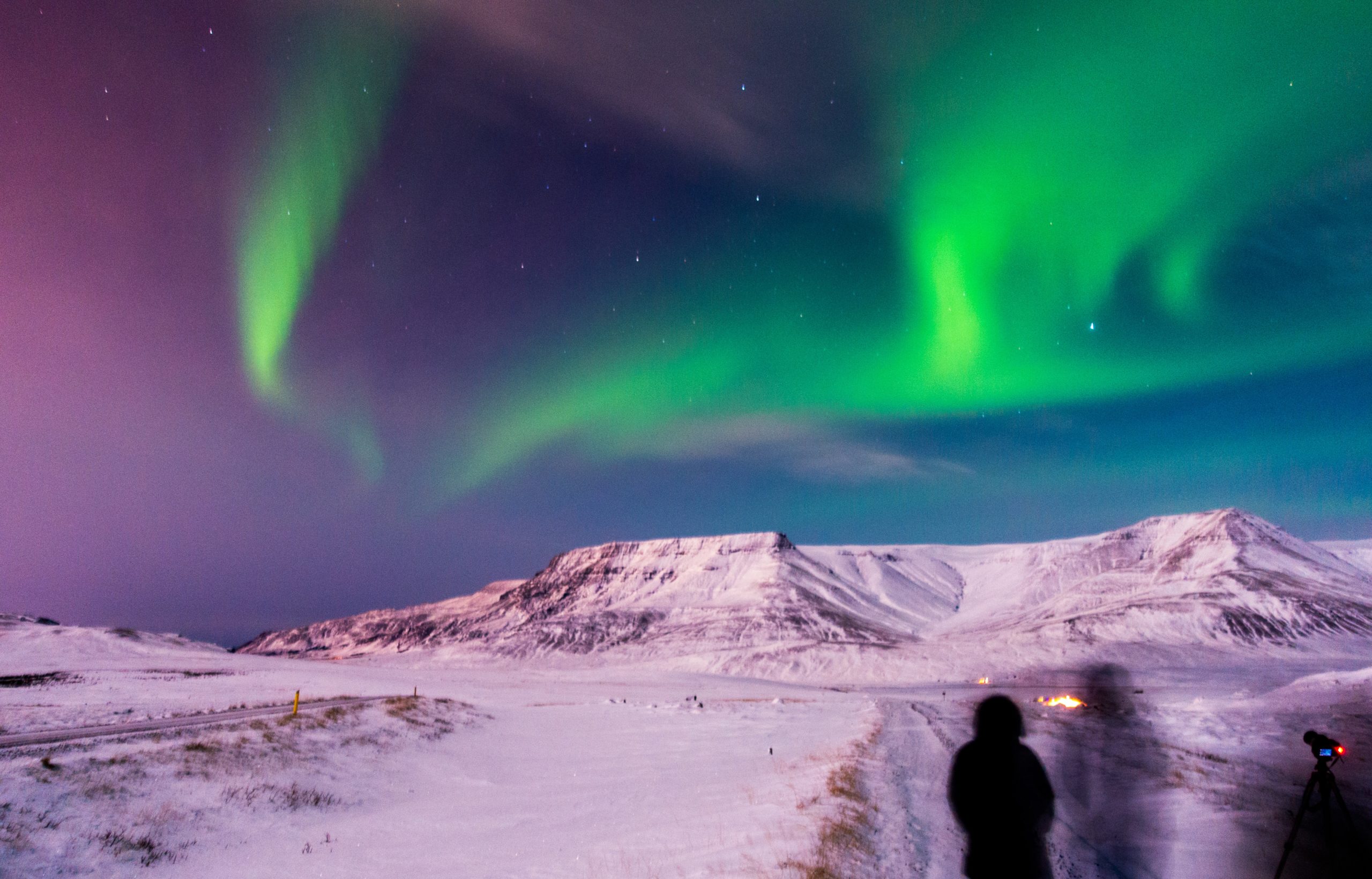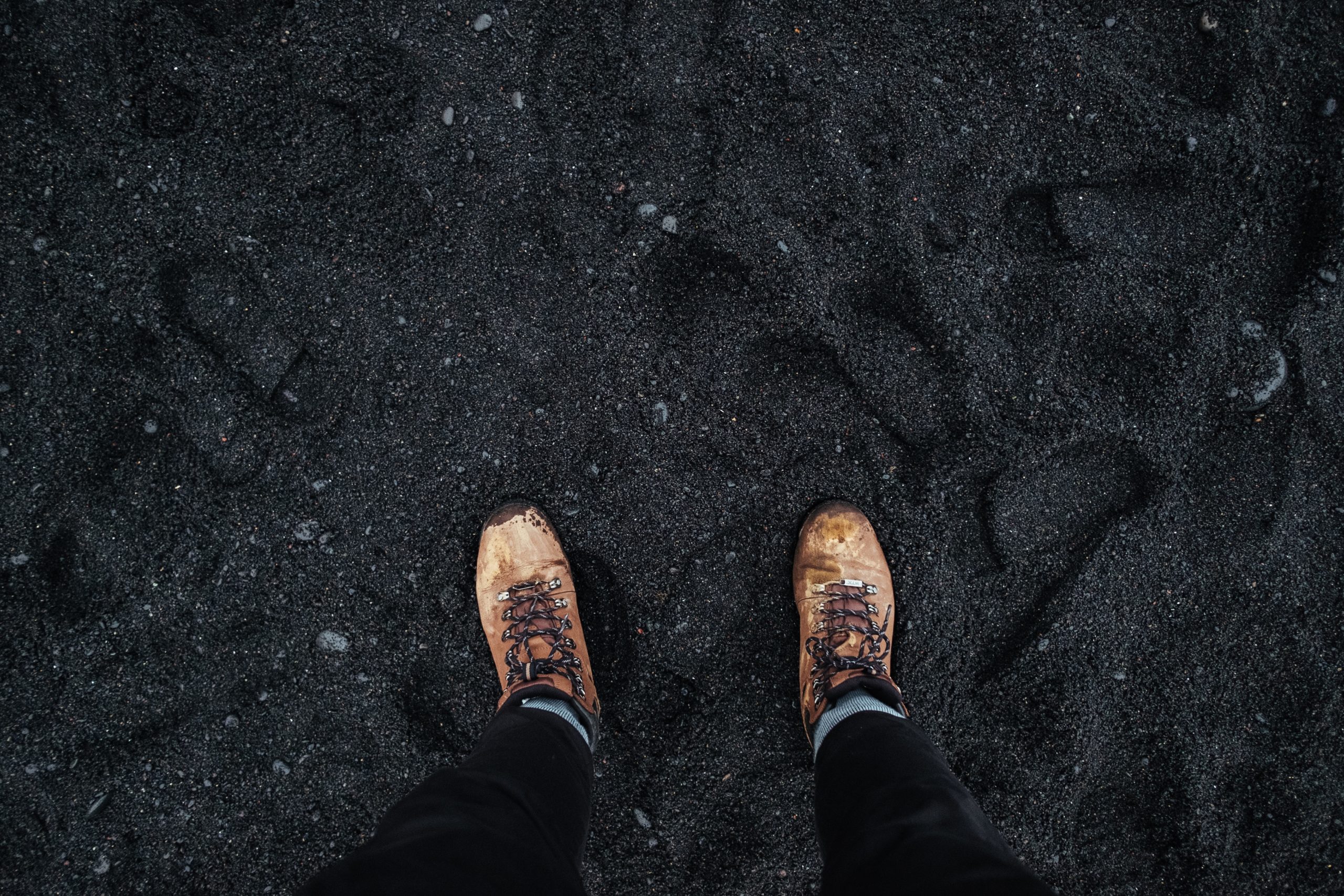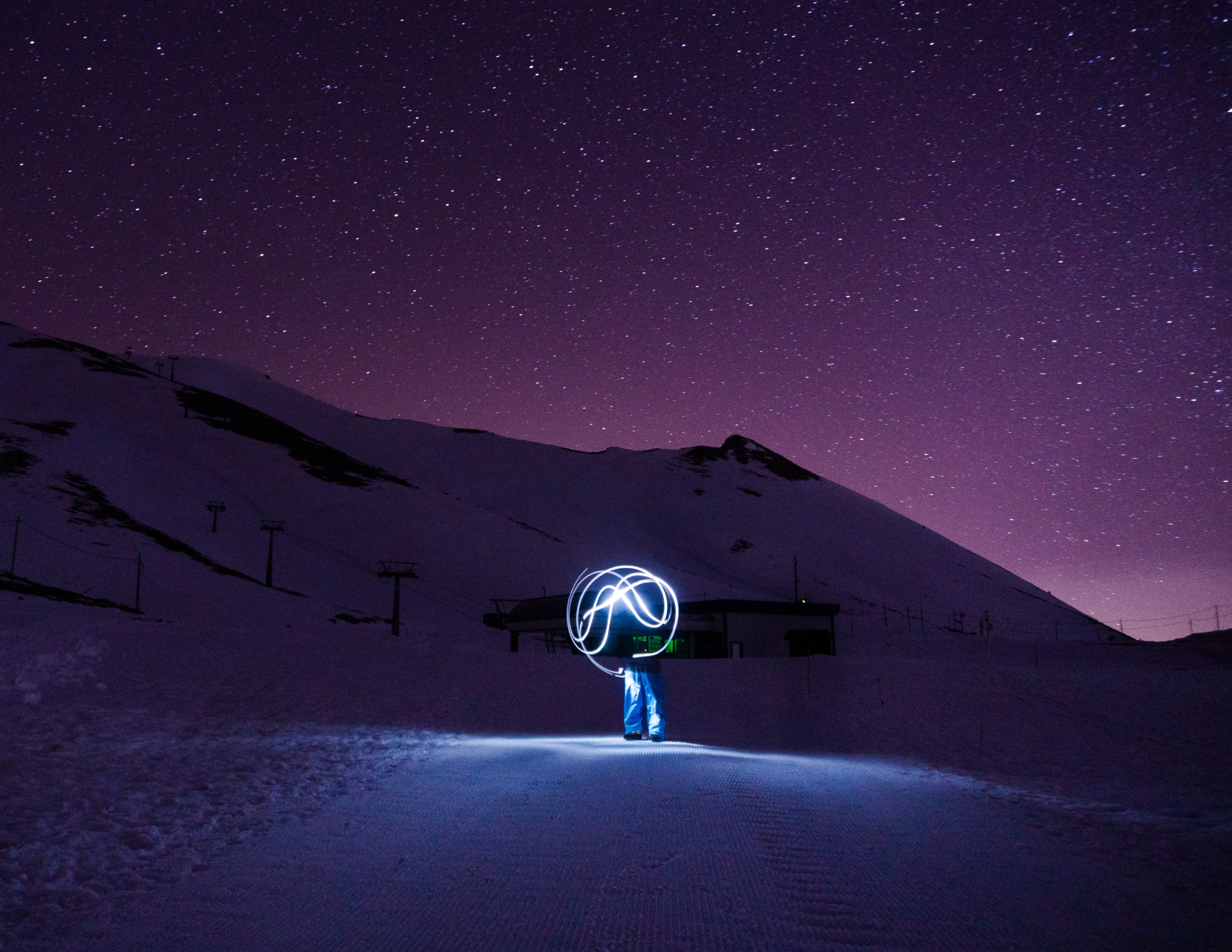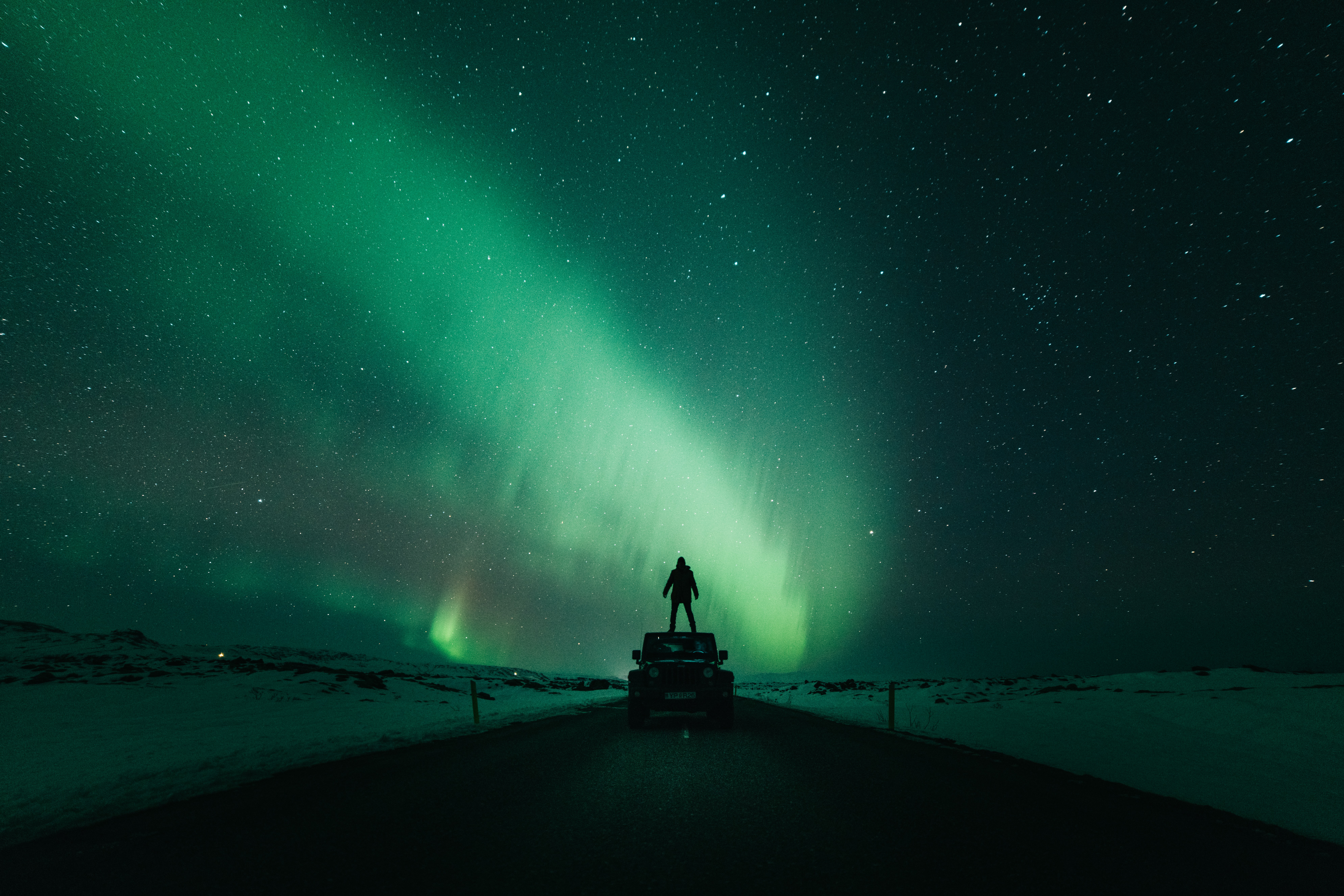Destination black sand beach Iceland: 10 of our favorite unforgettable beaches to watch the northern lights from
If you’re looking for some black sand to aurora watch from, look no further. With nearly 5000 km. of coastline, Iceland has you covered.
Picture it. Destination: black sand beach Iceland. Sparkling dark sand is the gift of many volcanic hotspots, but up here in the North, Iceland is among the few. Imagine the incredible darkness of sitting on the velvety black sand, while auroras dance in the black night.
Aside from the mystical moving lights, the only thing you can see are the stars and the white surf. It’s not a sight to miss, so we’ve gathered up a few of our favorites. Many things are otherworldly about black sand Iceland- but this is surely one of the most surreal.
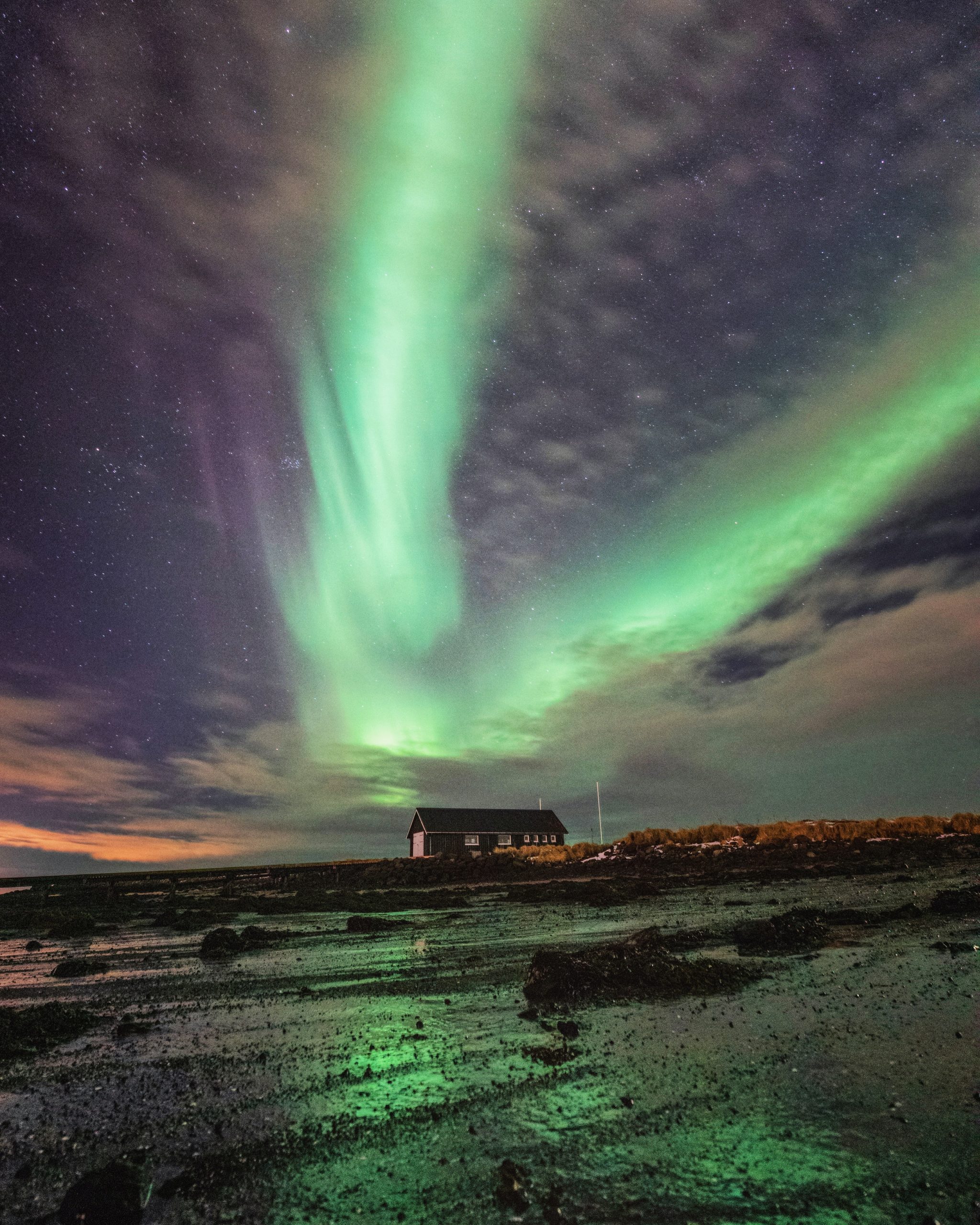
1. Seltjörn, Ægisíða, and Kirkjusandur: The City Coast
Despite Reykjavik’s cosmopolitan appearance, this is a seaside town. And with the sea, comes miles and miles of coastline. There are many places where you can’t access the water because of barriers, big rocks, or just a lack of places to stand, but these are not among them.
These three beaches represent only a fraction of the accessible coast, but they are gorgeous hideaways to stroll in the sunlight. (Or the moonlight, if you’re keeping an eye out and watching the tide.) If you’re enjoying a walk on the seafront paths, you can find Seltjörn and Kirkjusandur at either end of it.
Kirkjusandur is the closer beach to the city center, and like many city spots, depending on the tide it may or may not be there when you arrive! It is a good reminder that despite our concrete home, we are never too far from nature in black sand beach Iceland.
If you find yourself down by Grótta, you will have plenty of time to enjoy Seltjörn. The home of one of Reykjavik’s most notable lighthouses, a nature reserve, and a beloved aurora watching spot- this entire area feels lightyears removed from the hustle and bustle of the city just behind it.
And if you find yourself in Reykjavik’s cozy Vesturbær neighborhood, you can enjoy a walk down Ægisíða. An area of trails and recreation, Ægisíða is a tiny stretch of shore dotted with fisherman’s huts and reminders of a time when a day’s work was a good catch and a small boat.
On a clear day, you can see all the way to Reykjanes from this spot. There are many tiny beaches in the city, some of them with no name at all.
They are all different windows into what life used to be like, with different gifts like sea glass, urchin shells, and long strands of luminous seaweed decorating their shores. And if you’re careful, each one of them is a glorious place to watch for northern lights.
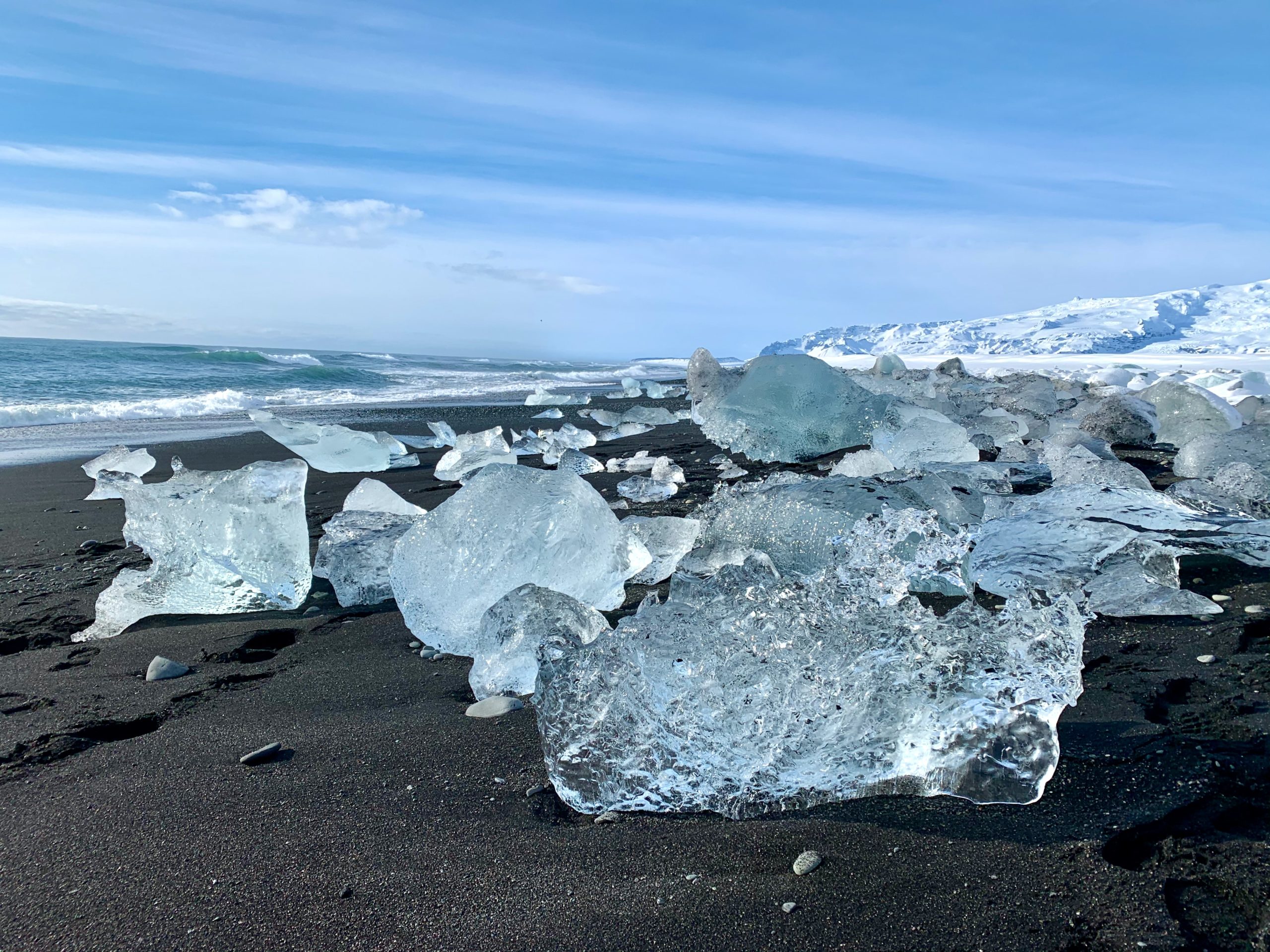
2. The world-famous Diamond Beach, also known as Breiðamerkursandur
When reading about black sand beach Iceland, it’s hard to miss the glory of Diamond Beach. A small piece of the larger Breiðamerkursandur coastline, this is a popular spot. Though it’s a bit of a drive from the capital this is the home of the Jökulsárlón glacial lagoon, and it is from there that the diamonds are provided.
This area is fed by the glacier Vatnajökull, which is so big that pieces of it have their own names. This part of the glacier is called Breiðamerkurjökull. As pieces of ice calve off of the glacier, they fall into the Jökulsárlón lagoon.
From here they travel out to sea, sometimes finding themselves festooned upon the beach there. These enormous chunks of ice bob up and down in the waves, heavy when they’re on the shore, but light as air when they’re being thrown about by the waves.
If you’re visiting black sand beach Iceland- you simply cannot miss a night spent among these titans. Black sand, chunks of ice as big as a man, and the lights coming down to dance on the lagoon.
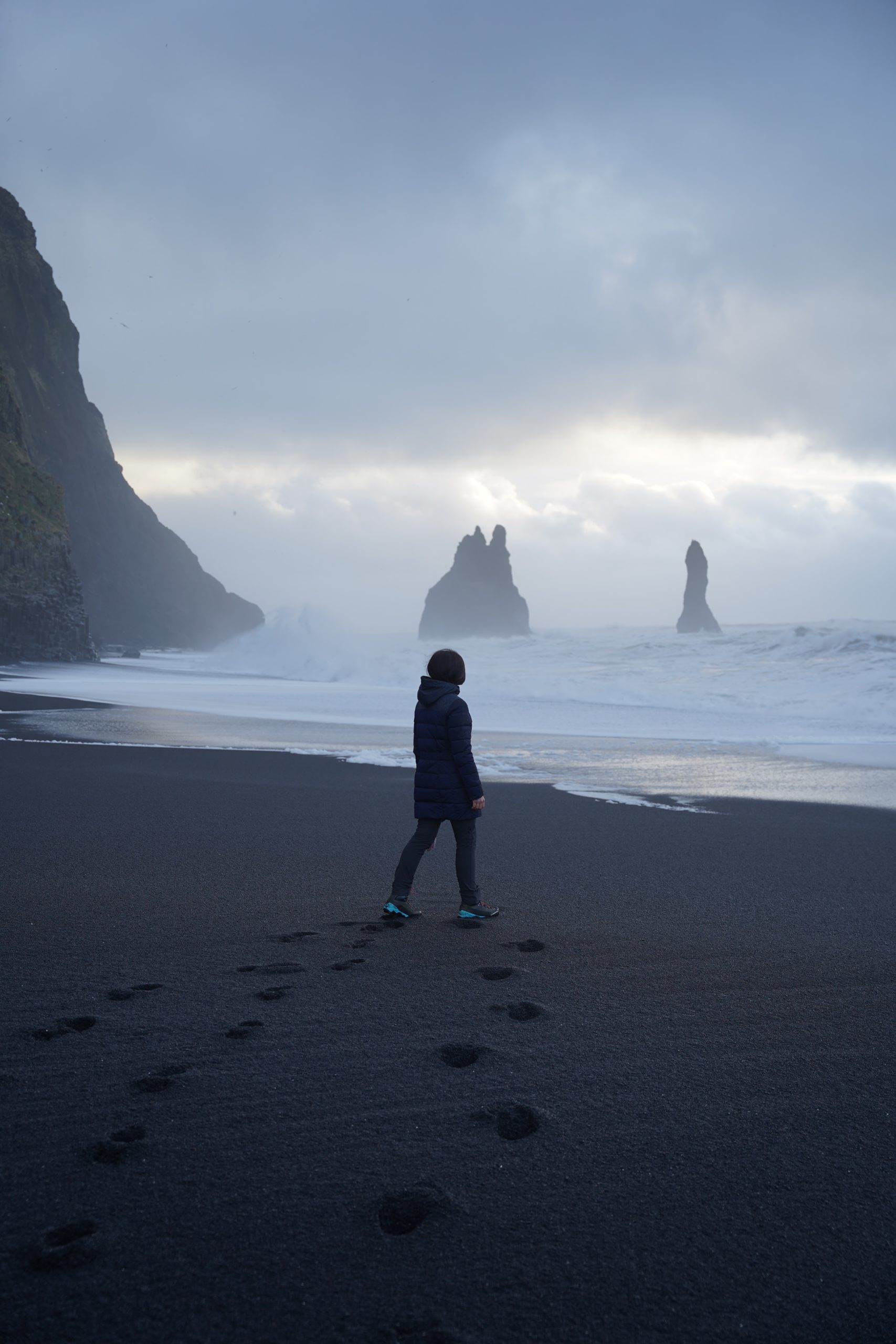
3. Reynisfjara: The postcard beach
A trip to black sand beach Iceland can’t happen without a stop on Reynisfjara. Charting as one of Iceland’s most dangerous beaches due to strong currents and sneaker waves, this beach in front of Vík has been featured in countless films and television shows.
Instantly recognized by its huge basalt caves, rock stacks, and the Dyrhólaey promontory. Iceland’s south coast is one long stretch of beaches and sand deserts. Many of these formed because of powerful volcanic eruptions and the glacial outburst floods (or jökulhlaup) that they created.
Reynisfjara is a great spot for grabbing a bite to eat or staying the night. If you plan to aurora hunt from here, make sure to keep a safe distance from the water. This beach is not staffed and getting caught in a sneaker wave can be deadly.
Fortunately, the town is right up on the beach, and you can watch the aurora from a cozy little bench among the dunes, while you listen to the crashing of the big waves on one of the most famous spots in all of black sand beach Iceland.
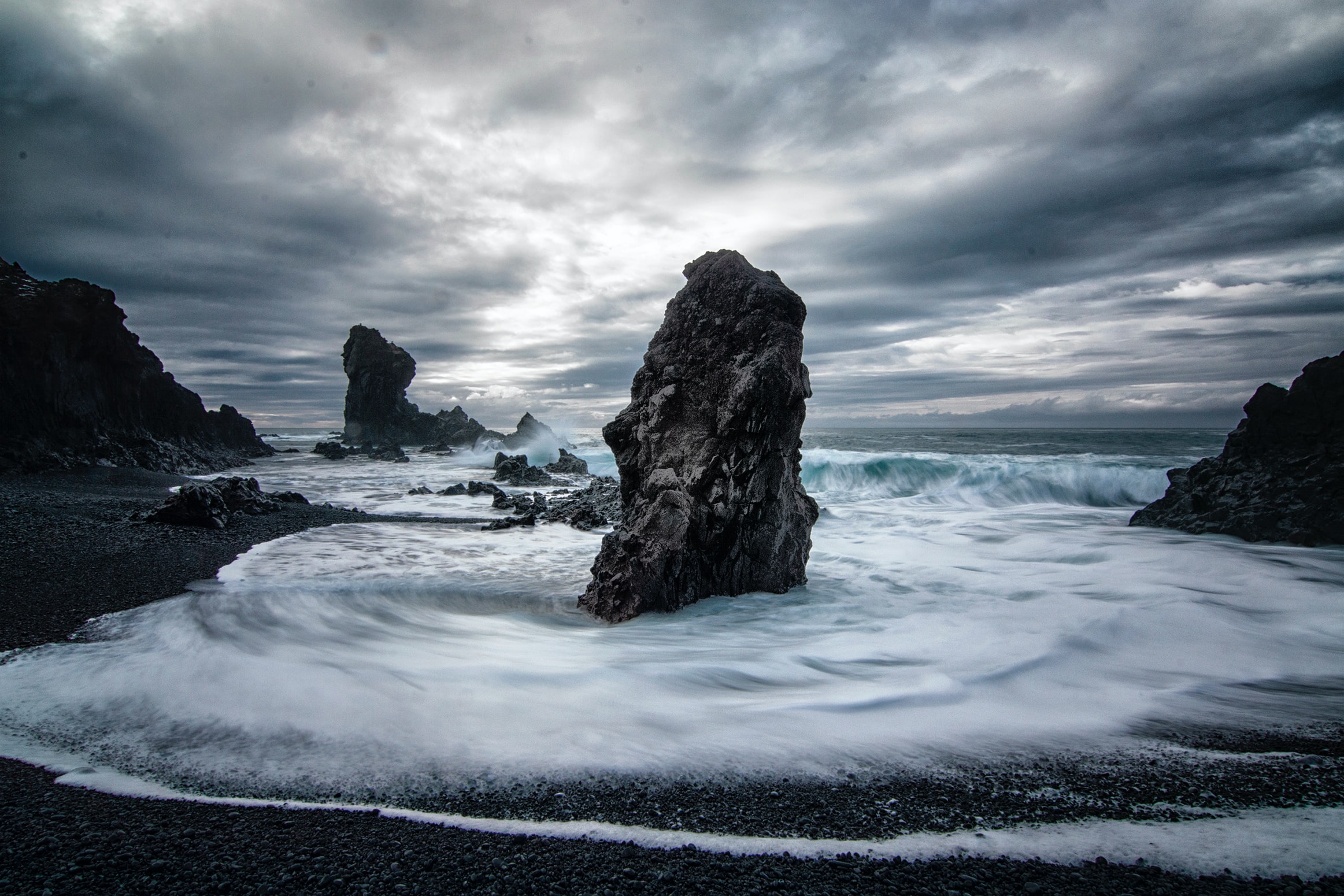
4. Djúpalónssandur at the edge of the world
If you find yourself in Snæfellsnes at the foot of another famous glacier, you must certainly make a stop at Djúpalónssandur. This is a place of many curiosities and treasures in black sand beach Iceland, so tread carefully here.
Located at the edge of the Snæfellsnes peninsula, you’ll find that the sand is hidden under a layer of polished black pebbled. These are Djúpalónsperlur, or the “Pearls of Djúpalón”.
They are protected, and so are the twisted pieces of metal that rest on top of them. These are pieces of the British trawler the Epine GY7, and they rest on this beach in memory of the men that lost their lives in a blizzard there.
This is only one of many stories on this beach, as it used to be an epicenter of activity when fishing was a smaller industry in the hands of the people.
Nearly all of the rock formations, springs, and sea stacks have names and stories, and tales of being elven structures or frozen trolls who saw the daylight. You could spend weeks in these coves learning the history of each mark in the land.
If you’re a history buff or a story lover in black sand beach Iceland, make sure to grab some literature about this area, and leave nothing but footprints in the sand behind you. This is a hallowed place of memories gone by, and a protected zone.
Not to mention, a remote area with similar wave patterns to Reynisfjara. Enjoy the aurora from a safe distance, and be respectful of the different souls that may be watching with you.
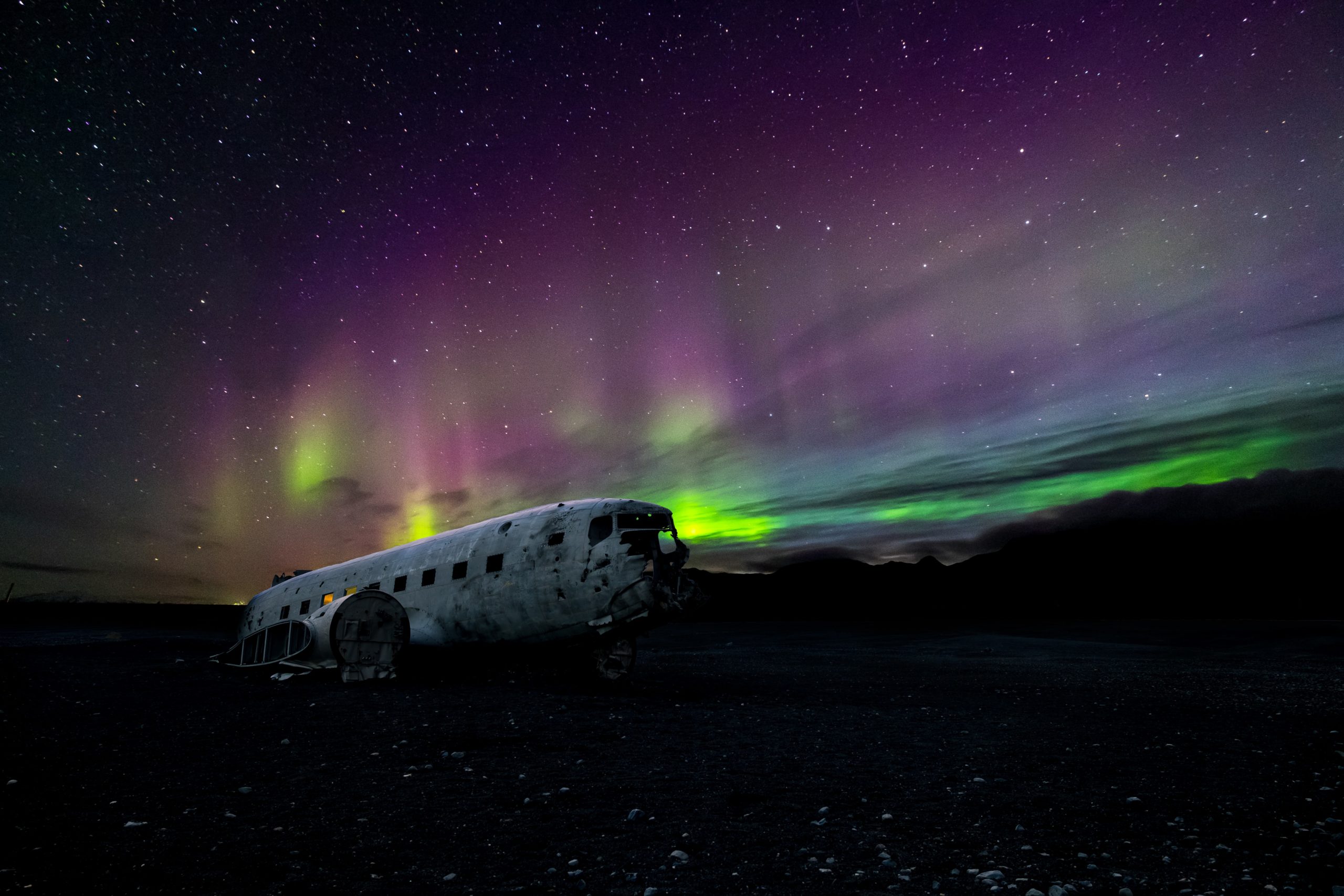
5. Solheimasandur and the plane wreck
There are a lot of beaches in black sand beach Iceland, but this is a special one. A smaller part of the big stretch of the long southern coast, Solheimasandur is another creation of volcanic eruptions creating glacial outburst floods, and the sand flats of this area are vast.
Because of its volcanic history, Solheimasandur is not home to any villages or large settlements. It is, however, home to the US Navy DC-3 plane wreck, a landmark sought by photographers and curiosity seekers alike.
In 1973 due to a fueling problem, this plane crash-landed here on the sand. All parties involved survived, and walked away from this impromptu landing in one piece, so it is not truly a memorial piece.
Getting to the wreck takes a bit of a walk, but it’s worth it to gaze upon this strange visitor among the sands. This is a truly desolate place, so take caution if you are visiting here in the nighttime or the winter season.
It is good to check ahead on the weather, as the sand wastes are disorienting and visitors in the past have gotten lost here. With little to nowhere to hide, it is possible to risk exposure and it is unlikely that you will come across much help.
Though this is a popular northern light photo opportunity, look out for your safety first. Those airmen walked away from this wreck, and in order to enjoy more of black sand beach Iceland, so must you.
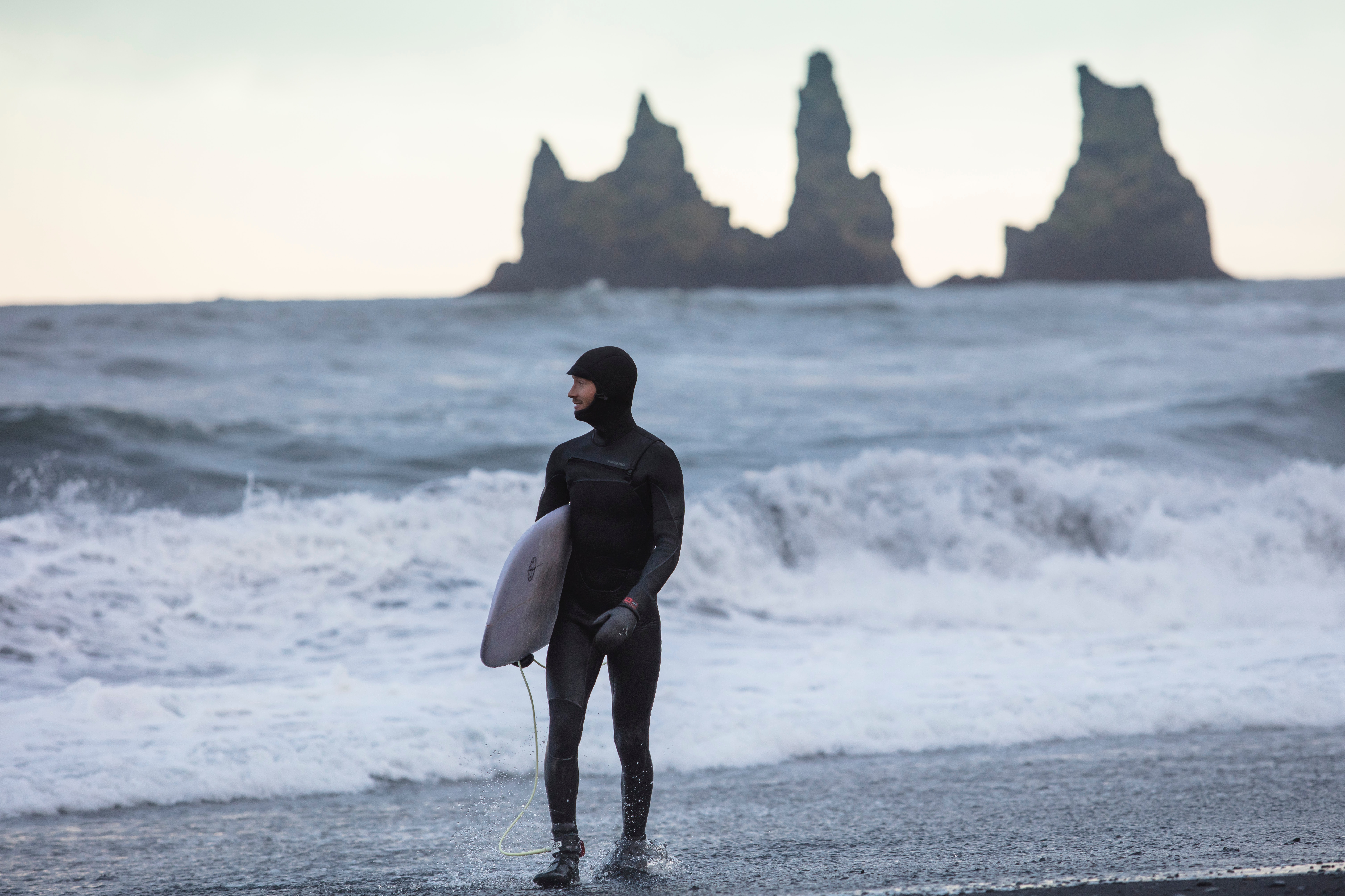
6. Catch a wave on Thorli Beach
The Reykjanes peninsula is known for its big, consistent waves, and believe it or not, is a long time favorite of arctic surfers. Thorli is a fairly advanced spot near the town of Þorlákshöfn (Thorlákshöfn) and it sports an unusual mix of both black and yellow sands.
Beloved by local and visiting surfers, Thorli is a long crescent of sand at the heart of Iceland’s surfing community. And though there are different waves to catch throughout the year, the high point for big surf is right smack in the middle of aurora season.
If you’re a seasoned surfer, this is the beach for you. (And if you’re an aurora hunter- the best of both worlds!)
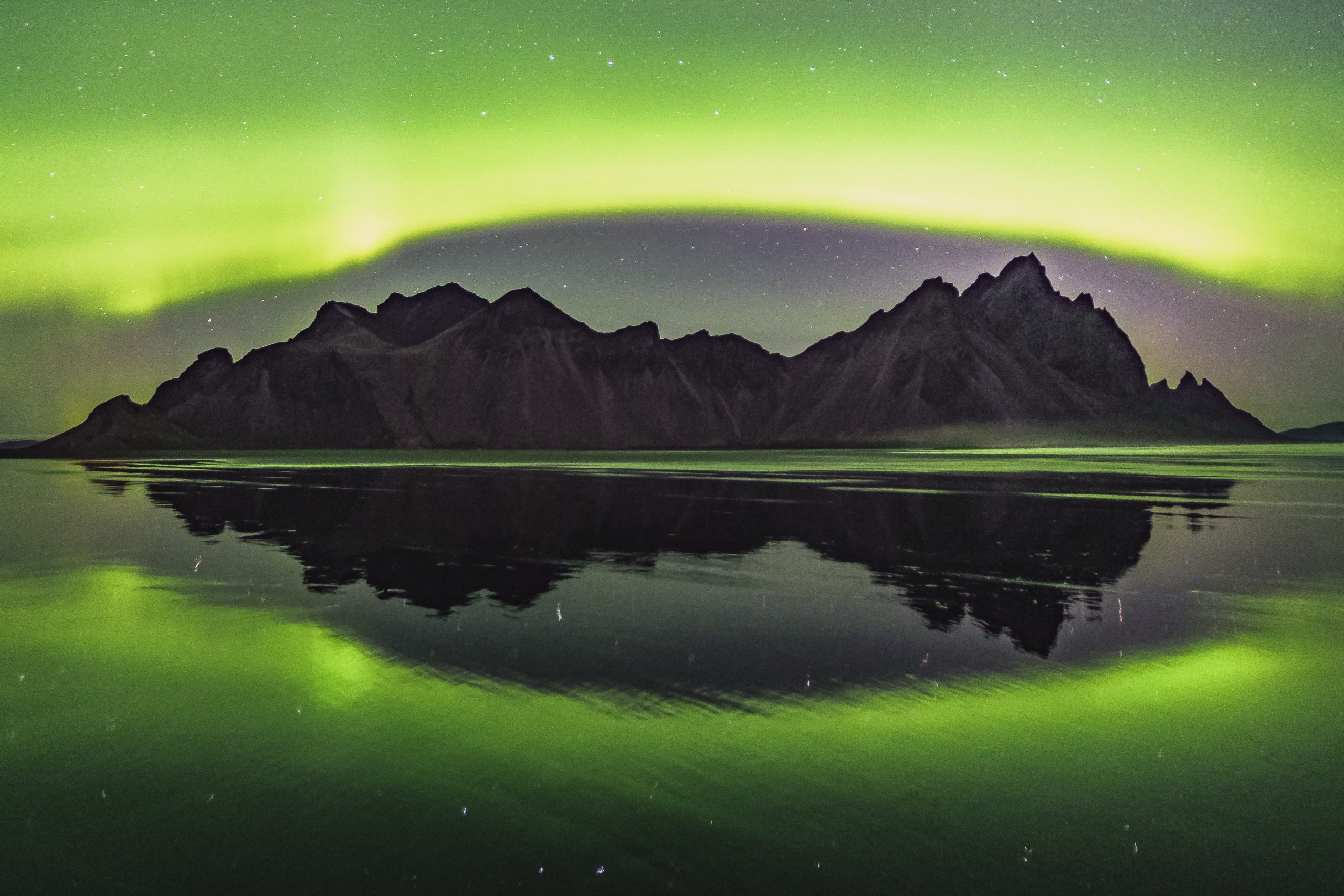
7. Stokksnes the Mirror Beach
Stokksnes is a photographer’s dream. At the eastern edge of Iceland lies the long flat shore of Stokksnes, and the jagged dragon’s-teeth peaks of Vestrahorn. Close to the town of Höfn, this area either welcomes you back to the sand deserts of the south or announces your arrival to the dramatic mountains of the east.
But before you go further either way, you should take a moment to stop at Stokksnes. This beach is wide and flat, which causes the tide to leave water behind as it recedes. This creates a shallow and incredibly reflective surface, allowing incredible reflection pictures of the mountain Vestrahorn, the surreal black dunes, and potentially, the colorful, dancing aurora.
There is a small fee to visit the beach, as it is privately owned land- but it is more than worth it to help preserve the majesty of this place.
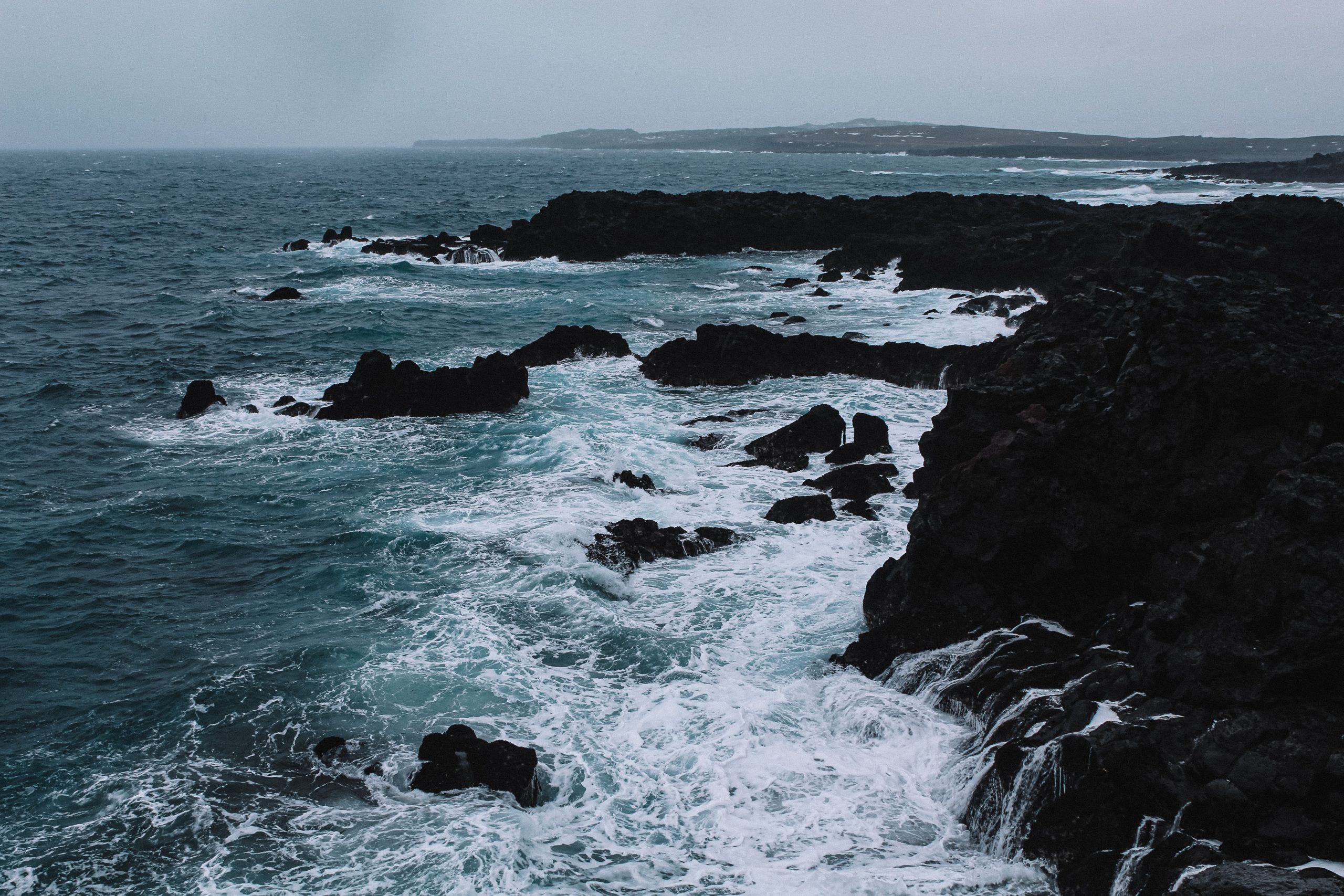
8. Everybody’s gone surfin’...In Sandvík and Grindavík
For those who aren’t ready to catch a big Thorli wave, there is the slightly more forgiving beach break of Sandvík, where many locals catch their first waves. Most of Iceland’s surfing beaches are reef or point breaks, which means you’ll be dodging a lot of sharp volcanic rocks, and maybe some sea urchins.
For those who are only here to watch auroras, you are in great company. The peninsula of Reykjanes boasts long coasts of lonely beaches, and many friendly seaside towns to pick up snacks in.
(Including Grindavík, one of Iceland’s happiest towns! And the nearby neighbor of our recent fissure volcano, Fagradalsfjall.) In black sand beach Iceland, you can’t go wrong with cruising quiet Reykjanes.
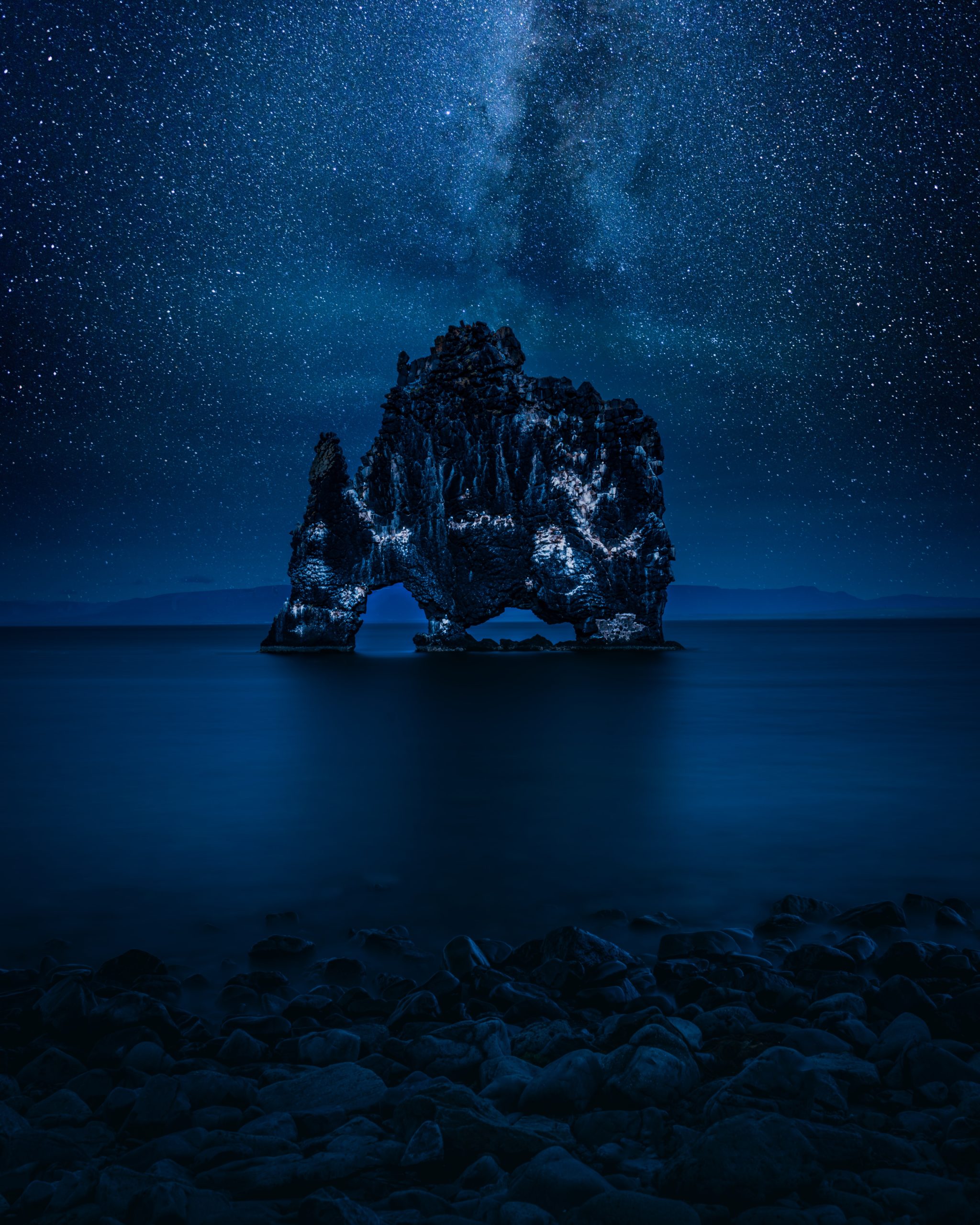
9. The Seal Circle at Vatnsnes
You’ve heard of the Golden Circle, and even the Diamond Circle- but what about the Seal Circle? The 711 road around the peninsula of Vatnsnes is a great spot for black sand, seals, and auroras. If you’re lucky, you can spot harbour seals, grey seals, harp seals, bearded seals, hooded seals, ringed seals, and maybe even a rare walrus or two!
The Illugastaðir beaches on the western side of the peninsula have been a notable home for them for many years, but these creatures can be spied year round throughout the peninsula. It is even possible to see them on the eastern side basking near famous Hvítserkur, a popular aurora photo spot.
You can stop in Hvammstangi to visit the Icelandic Seal Center to learn more about these curious residents, but don’t forget to keep your eyes on the sky. This is a popular aurora spot with low light pollution and many beloved foreground landmarks for great aurora shots.
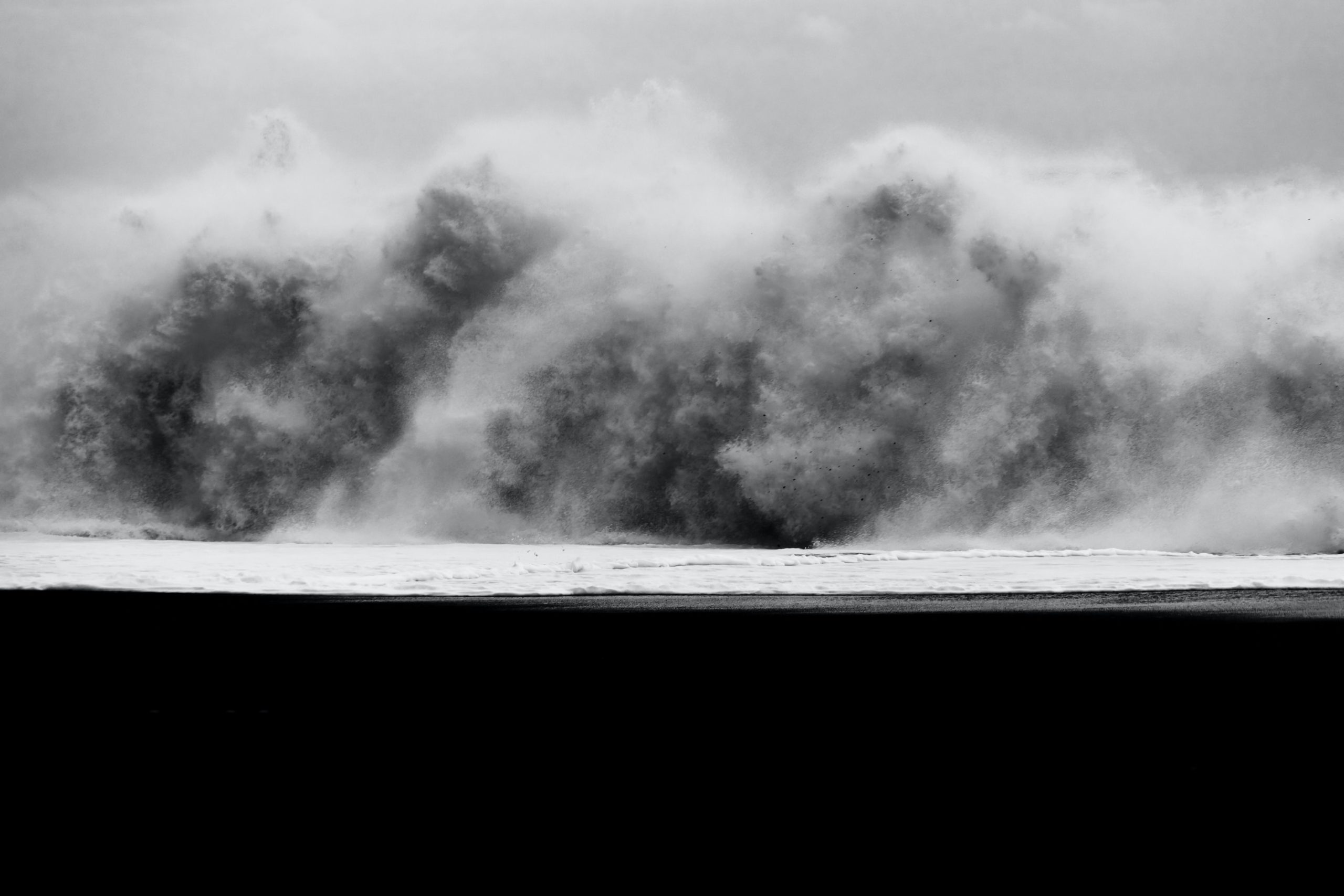
10. Ólafsfjörður on the Arctic Coast Way
North Iceland is a magical place punctuated by a more extreme climate, big mountains, and beautiful small towns throughout the fjords. There is a lot of history and tradition here, and even though it’s not by much- you are that much closer to the pole when you visit.
Ólafsfjörður is located in between the shark fishing village of Siglufjörður in the north, and Dalvík just below- home to world class skiing and “The Great Fish Day” festival (Fiskidagurinn mikli). This is another great peninsula to explore, and you guessed it, every single one of these towns boasts its own piece of black sand beach Iceland.
These are long, picturesque coastlines framed in by tall mountains and sweeping fjord views out to sea. They have long histories and unique cultures, even from village to village. And just like their skiing, when it comes to auroras- they are unparalleled.
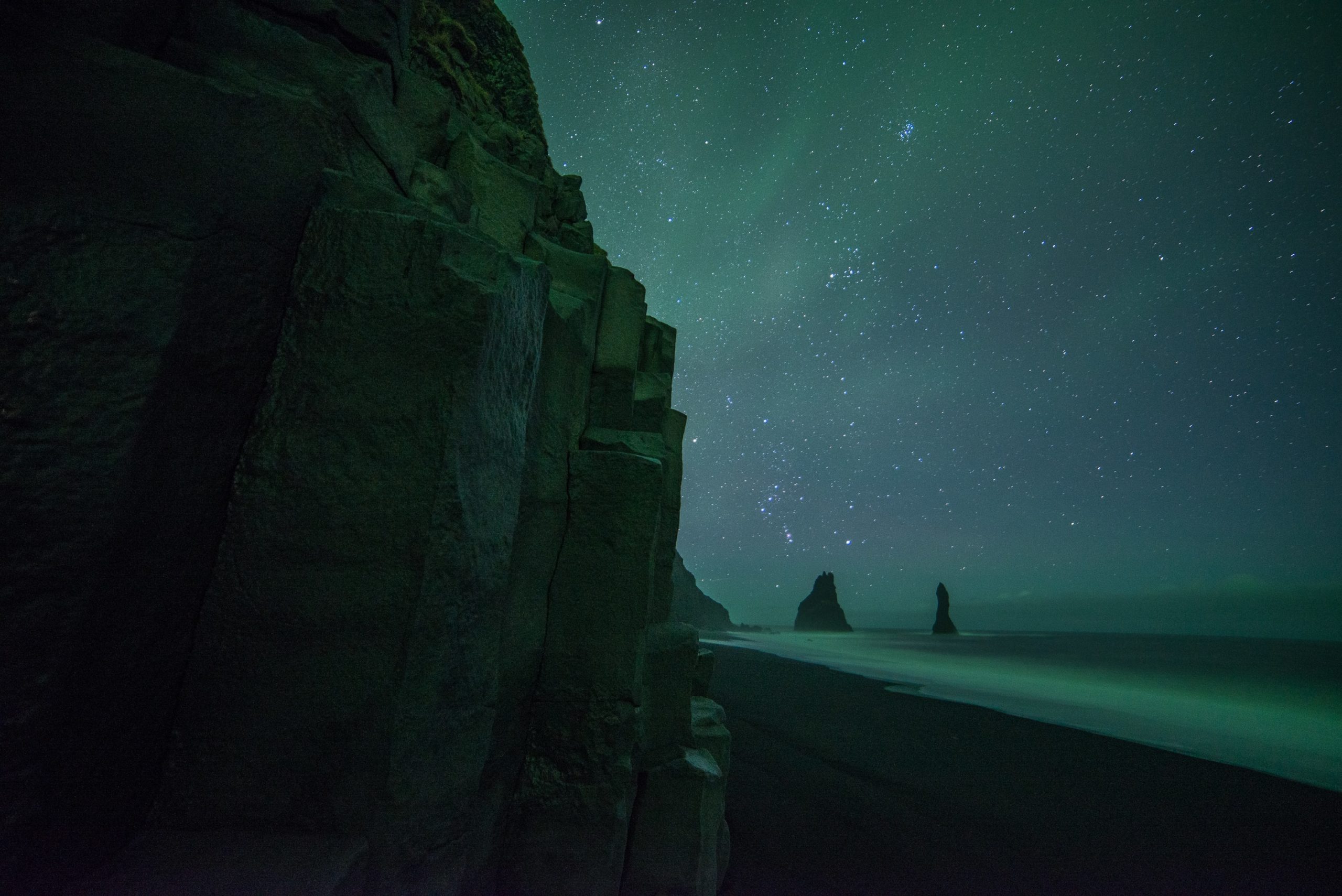
Northern Lights Painting...and 5 other fun things to do when the lights aren’t out
We spend a lot of time looking for auroras, but what do we do when we can’t find one? Fellow hunters, meet northern lights painting.
Northern lights painting may not be the first thing you think of when you pack your bags for a hunt. (And it might mean something different to different people! Don’t worry, we’ll come back later for the crafters.)
But if we’ve learned anything at all from years of chasing the aurora, it’s how to be prepared for any and all kinds of nights. Whether there’s a show to see, or not.
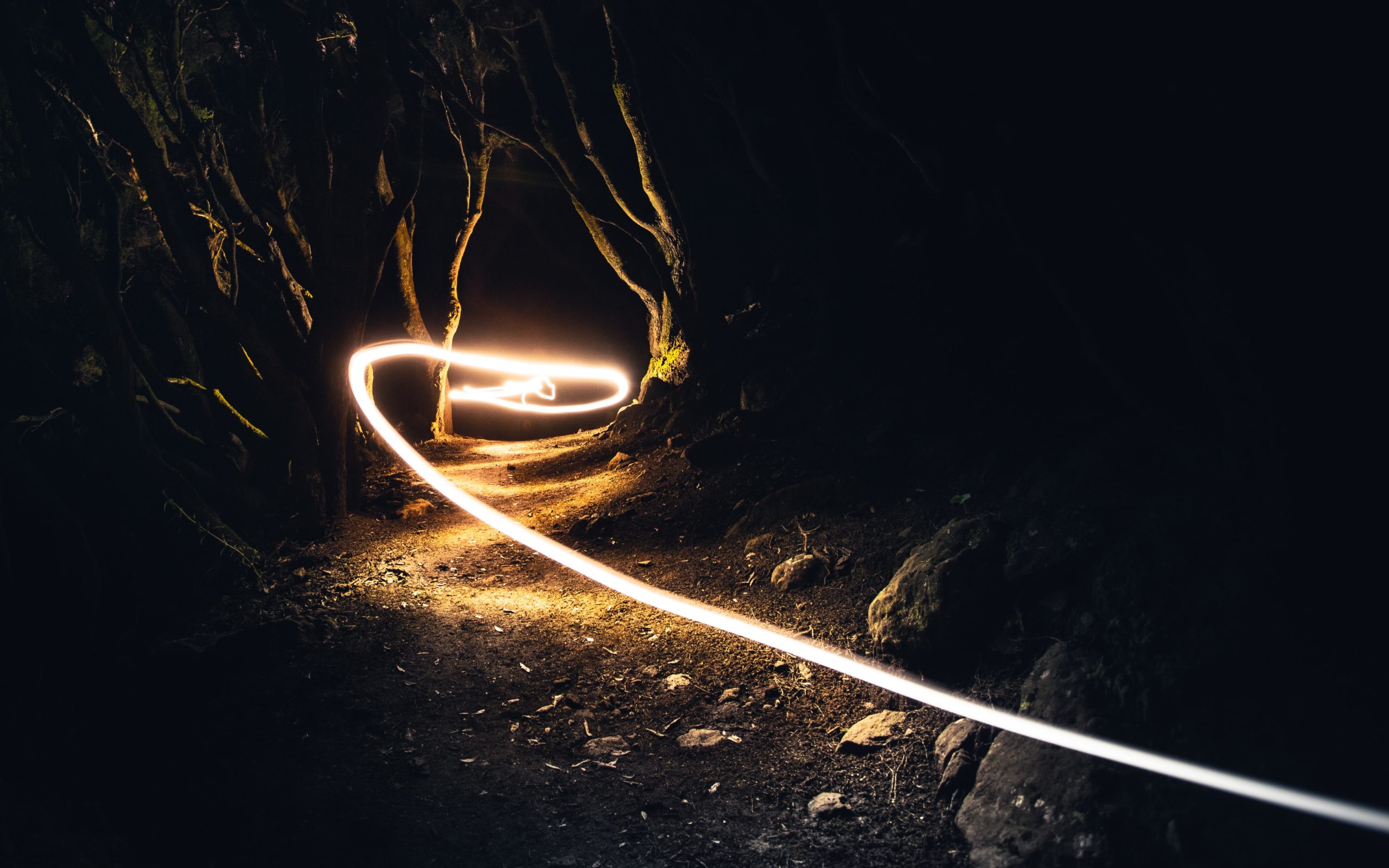
1. Light painting, or, Northern Lights Painting
Known as “Light Painting” or “experimental long exposure photography”, this is the ultimate activity when you’re waiting on the lights to show up. It may not be auroras, but it’s a fan favorite for a dark night with no show.
Popular in its own right, light painting or, northern lights painting, as we like to call it, is an activity that requires a camera. All you need to do this is a DSLR camera or a camera that can accommodate a long shutter setting, a tripod or flat surface, and a light.
This is an experimental process for a reason, and there is no wrong way to do your own northern lights painting. (Well, as long as you’ve got the flat surface and the long shutter. If your camera is moving you’ll have a hard time capturing an image, and if you can’t access a longer shutter, it will be harder to create these effects.)
That being said, this is an activity for people of all levels of artistic skill. The photos you make will look differently depending on where you are, what settings you try, and what tools you use to create light.
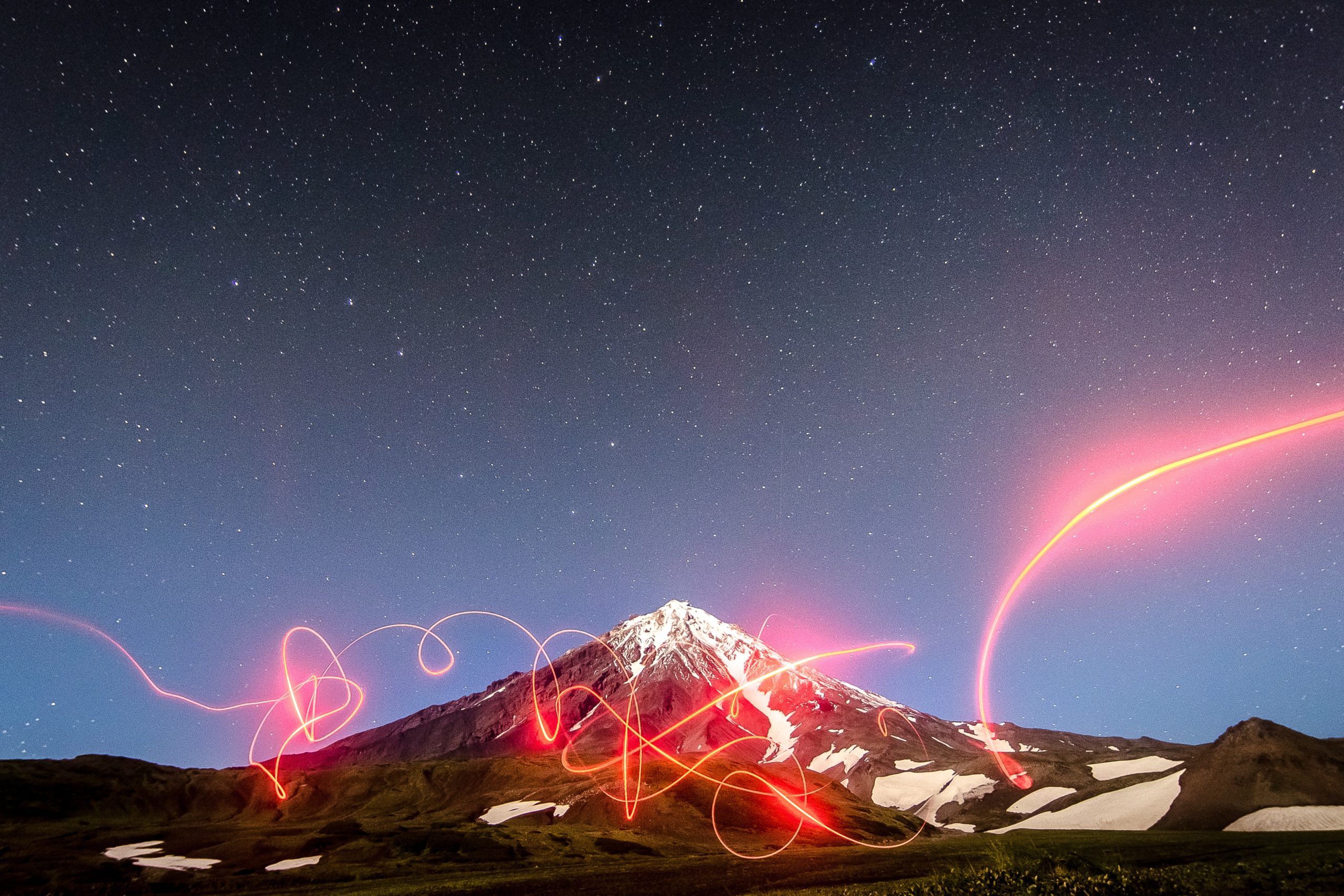
You can even do this inside! (Though, we find ourselves doing this outside most of the time, since we’re always waiting on the aurora to show up.)
Once you’ve got your tripod and your camera set up, you’ll be using a lot of the same settings you’d use for a northern lights shot. This means low aperture, and typically a higher ISO than you’d use for a daylight photo.
(Depending on the effect you’re going for, this could be an ISO as low as 400, and as high as 3600- but don’t take our word for it! This is art, so you’ll have to try different combinations out to see what look works best for you.)
And the key of course, is the extended shutter. Most cameras can accommodate up to 30 seconds of shutter, which is plenty for time for you to create a compelling shape or image. If you find that this is too bright, remember the golden rule of northern lights painting, and adjust till you get the look you want.
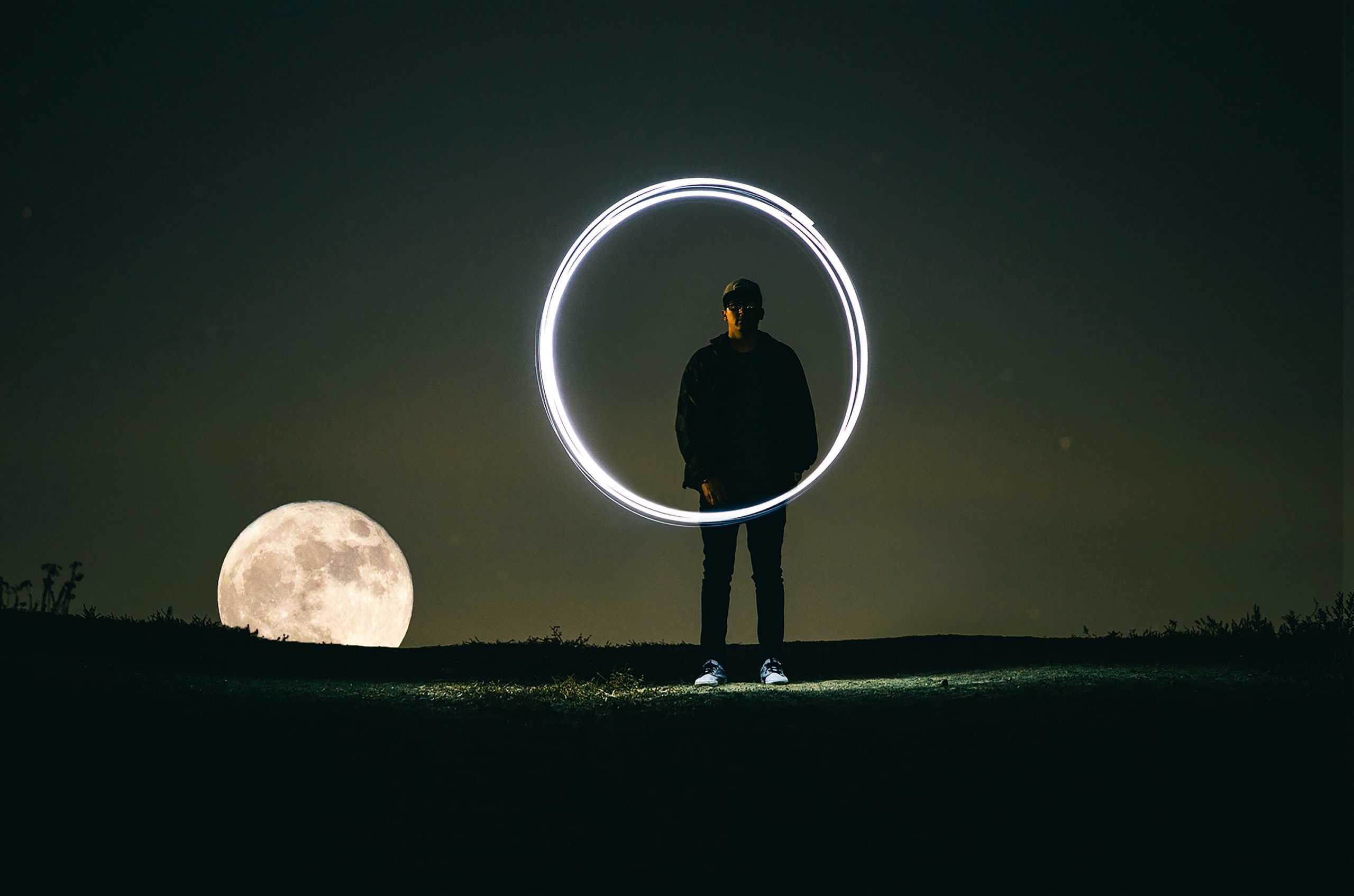
These photos are created by manipulating lit items in the camera’s field of vision. This means you can use fairy lights, mobile phones, torches, sparklers, LED tools, and so on. You can write messages, create three-dimensional patterns, draw shapes- the opportunities are endless. You can make your own aurora! (It is northern lights painting, after all..)
This is a great activity whether or not the lights are out, and we suggest checking out the work of other light painters. There are a lot of opinions on the best types of light, how to diffuse light with tracing paper, and how to color white light with plastics.
There are also countless tutorials on how to make the tools themselves, in order to achieve certain looks. (We are big fans of the long piece of wood with fairy lights taped to it.) If you choose to go the sparkler route, be careful!
Activities like this can spark dry grasses and create wildfires. Make sure you are operating in a damp area, and practicing fire safety while you work. No photo is worth an accidental blaze.
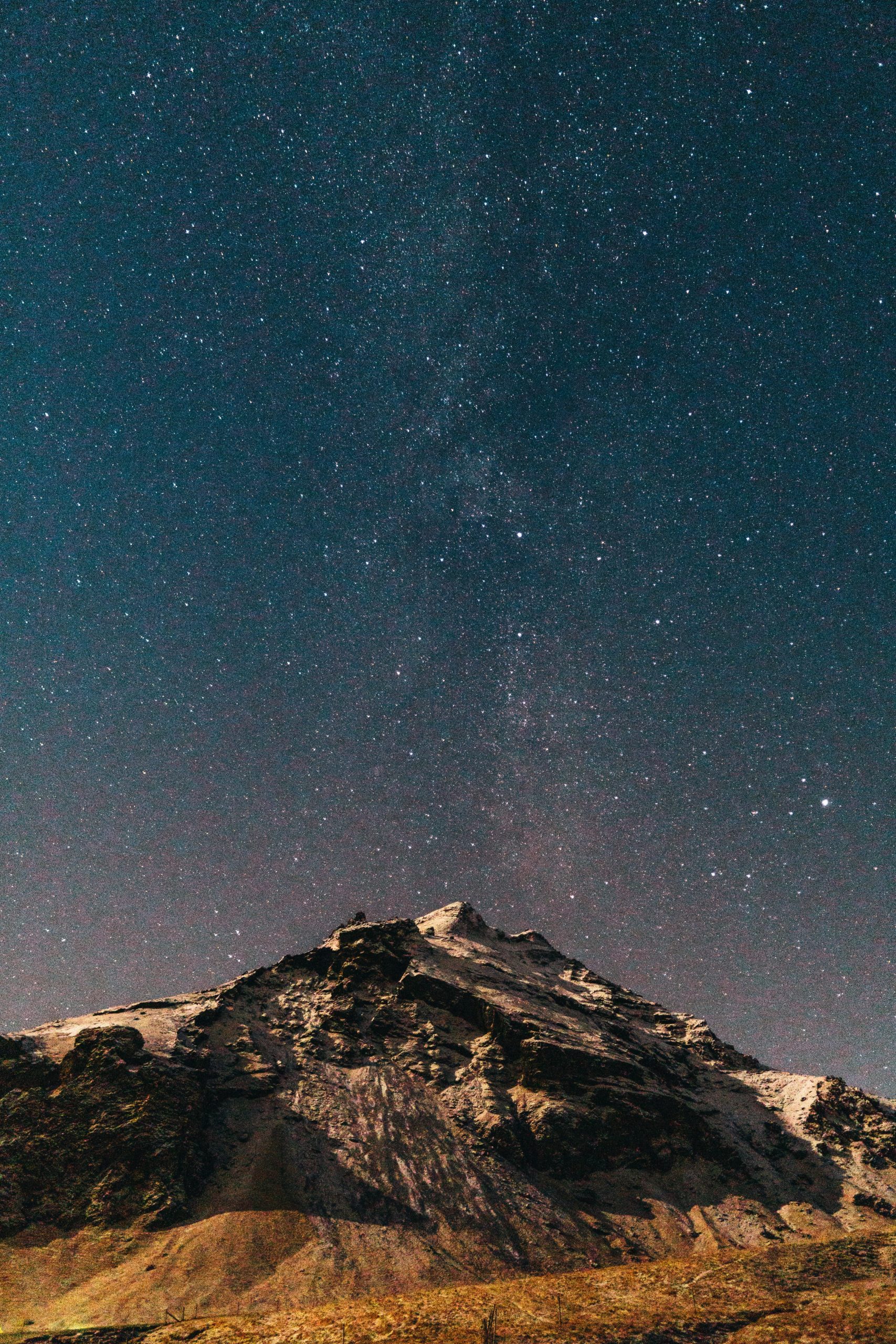
2. Stargazing and Telescoping out the heavens
Northern lights painting gives us something to do down here on Earth, but what about when we’re back to eyeing the skies?
That’s when it’s time to stargaze. While this activity does require the same clear skies as auroras, it doesn’t necessarily require any special equipment. (But don’t worry gadget collectors- there definitely is some.)
With a little knowledge and a lot of darkness, you can find constellations, planets, nebulas, and all sorts of celestial bodies. One can follow satellites, shooting stars, and even an eclipse or two in the Icelandic sky. (And you ought to make the best of it while you can, because we miss out on nearly ever summer event!)
However, if you want to elevate your stargazing experience, there are a lot of tools that can help you do this. Telescopes, binoculars, star maps, and more apps than you can imagine exist just for this very purpose.
Stargazing is a burgeoning hobby with an incredible community, and depending on where you are- there is likely a whole contingent of fellow gazers that you can learn from and watch with.
There also happens to be a lot to learn, so this hobby may stay with you far beyond an Icelandic holiday. Amateur space weather enthusiasts all over the world are even helping contribute to modern science.
In fact- it was stargazers that helped us understand STEVE. But, it’s a wide world out there. What far off planets or mysteries of the verse are YOU going to discover?
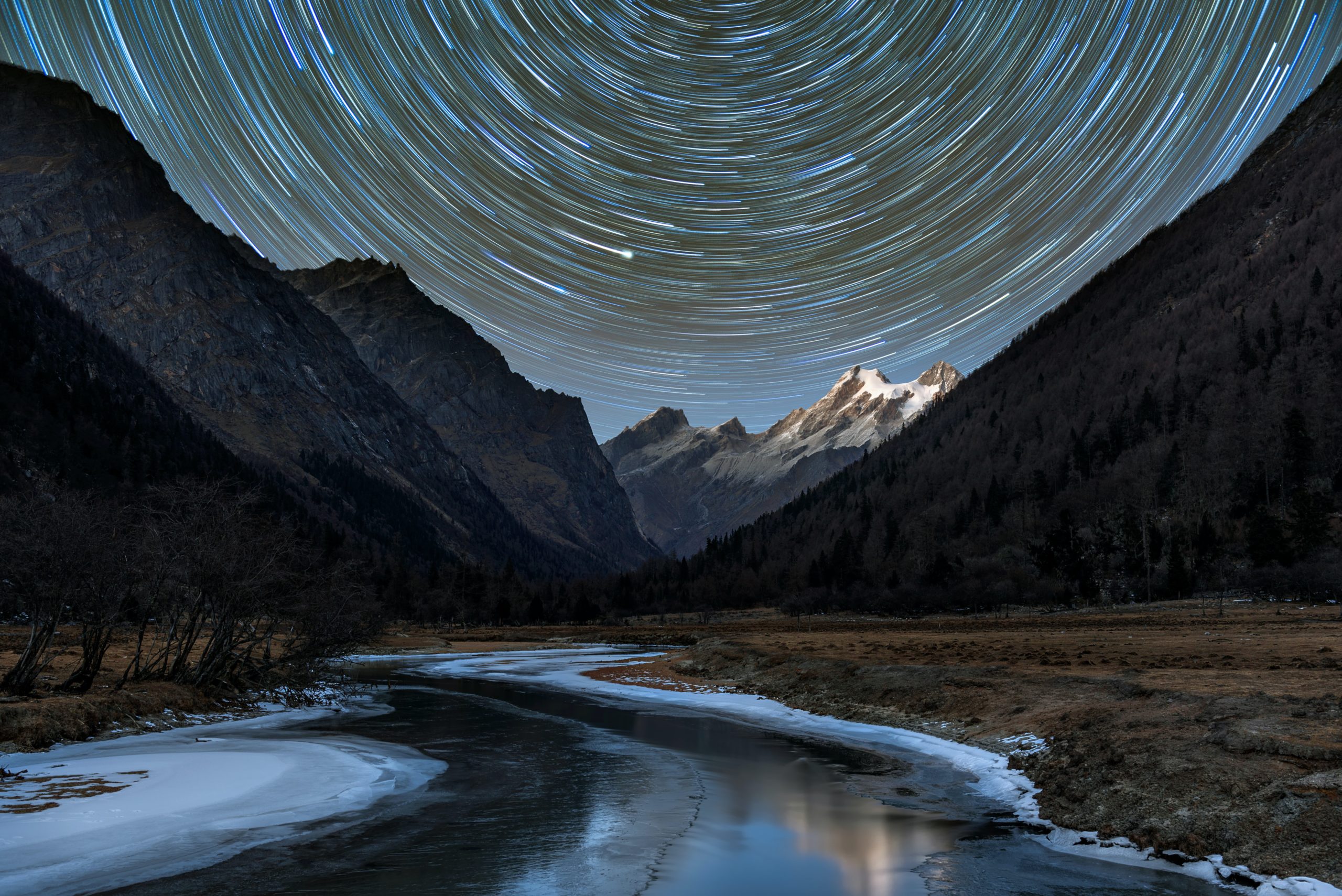
3. Astrophotography, Star Trails and Galaxy Hunts
While stargazing and northern lights painting can both become camera-centric activities, this is definitely one. Many aurora hunters end up becoming photographers out of necessity- because it is just too hard to chase such an ethereal thing and not keep a piece of it for yourself.
Photos are one of the many pieces of the magic, and they are not easily come by. Their rarity and the work that goes into making them is in some ways just as rewarding as the aurora hunt itself.
(Not to mention, a well-timed photo can be a great early detection tool in actually finding the northern lights on a dim evening.)
As many of you know, a great photo is the ultimate souvenir. It’s hard for a t-shirt or a fridge magnet to beat that kind of memento. But what do you do when there’s no aurora to capture?
That’s when we widen our scope even more, to astrophotography. Astrophotography is a big term that includes aurora photos- and about a thousand other things. The reality is that we can access so much more of the sky than we realize.
With the naked eye and our usual context in light polluted places, there’s a lot that we don’t see. But with a great lens (be it in a camera, telescope, or slick pair of binoculars,) suddenly the far rings of Saturn, or the super up close topography of the moon, become easily viewable.
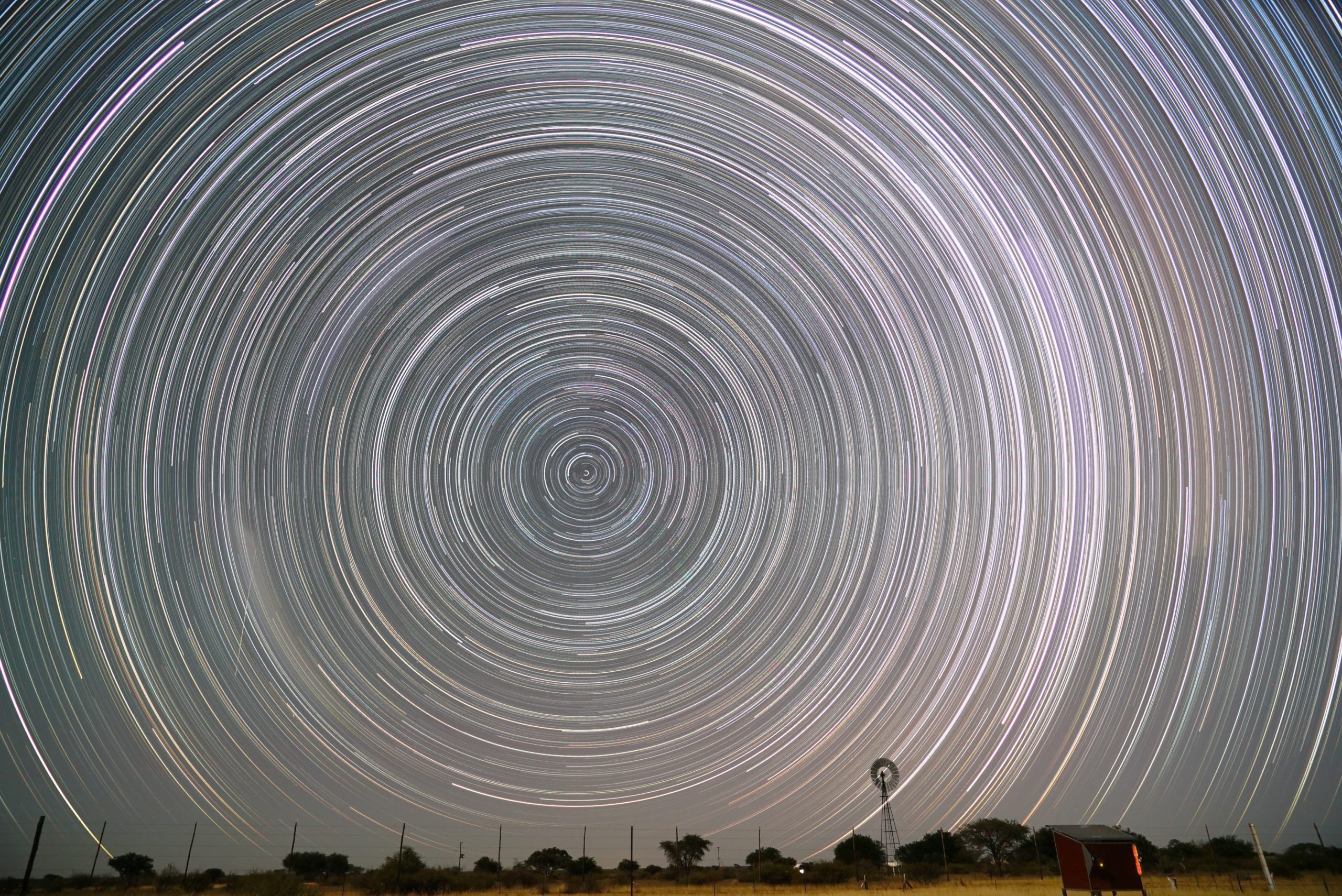
Star Trail images
So after you’ve done your northern lights painting of course, turn your lens to the stars. If you’ve got your tripod and plenty of battery, you can create star trail images by setting your focus to infinity and using the longest exposure you’ve got available to you.
This can be a tricky situation, because you may need to set your camera to the bulb setting, or acquire a cable release for your specific camera model to allow these unusual levels of exposure. (We are talking about 15-30 minute long exposures here!)
But, thanks to aids like Startrails, you can also take shorter exposure images, and the program will layer them together for you. This process makes this type of photography a bit more accessible to the novice astrophotographer, and it cuts down on image noise as well.
This is a special branch of nighttime photography, so have a look around if you’re interested! There is a whole world of star trail enthusiasts, and a million tried and true practices for getting the kind of images you want.
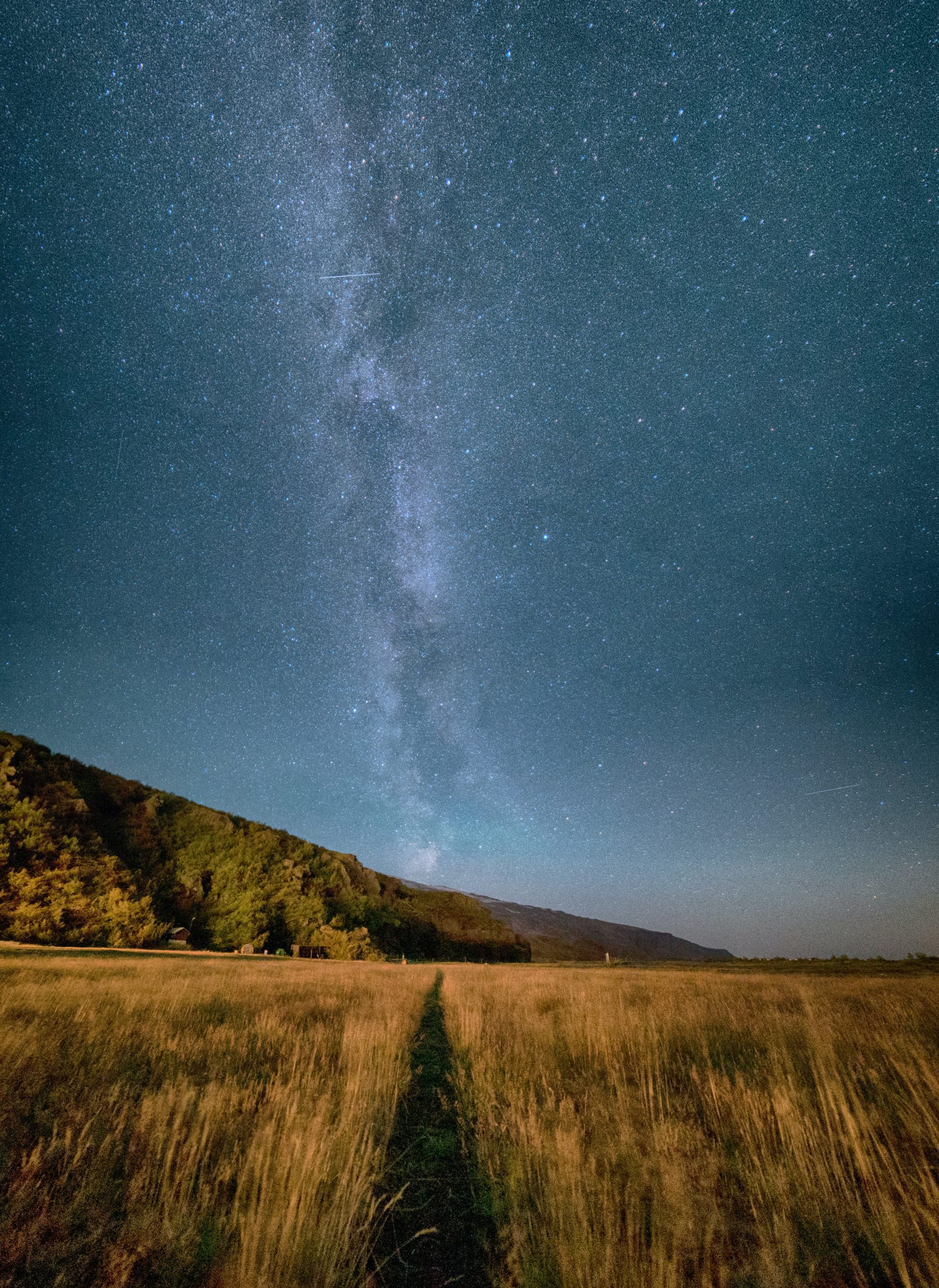
Galaxy Photos
If you’re looking to capture nebulas and far off bodies of celestial light, you may need some specialized gear. Many of these photos are taken with professional attachments and some are even captured through telescope attachments!
If you’ve got a telescope with you and want to venture into that realm of photography, go forth and please send us a copy! We’d love to see it. But for those of you who are trying to capture a galaxy with your DSLR, you may be in luck.
It’s not the easiest, but it is possible. You’ll need a lot of the same stuff you’d bring with you for northern lights photos, so make sure you’ve loaded up your manual capable camera, a sturdy tripod, a fast lens and some patience.
A new item that you’ll need is a starmap app. An interactive map can help you locate the milky way for that evening, which will cut out a lot of the guess work. Above all, you need to be in a dark place. Just like aurora hunting and northern lights painting, light pollution drowns out the good stuff.
Just like the star trail photos, you’ll be working with a pretty long shutter. As you try this out, don’t be disappointed if your photos don’t look quite as outrageous as some of the galaxy shots you’ve seen.
Many photographers in this field are utilizing specialized gear, processes like time blends and startracking, and doing a lot of heavy lifting in a post processing software like Photoshop.
These images are sometimes the product of a great composite job, or a lot of really skillful editing in a RAW image. You can certainly capture a viable shot with your regular aurora gear, but if you’re interested in this- don’t despair! All of these tricks can be learned, and there is ample information on the web to help you. Everybody has to start somewhere.
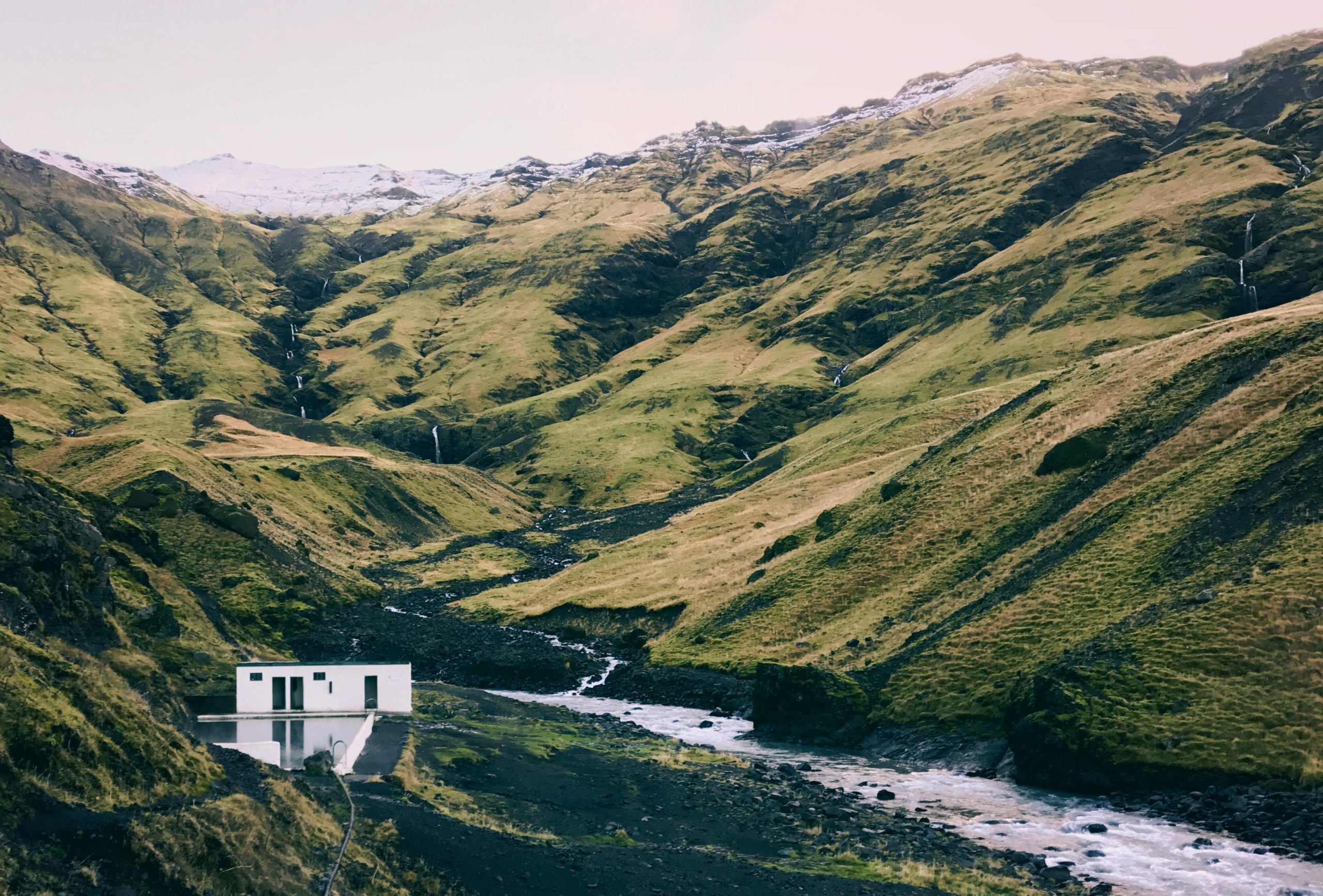
4. Hot spring night soaks
Now here’s an activity that you don’t need a camera for. (Unless you want to make some friends extra jealous.) Half of the time, we’re doing this instead of setting up the cameras- and sometimes the lights come out anyways!
The best seat in the house is always in the hot pot. Iceland’s geothermal landscape is a treasure chest of natural hot springs and great places to soak. But despite that, Icelanders have installed geothermally heated swimming pools in nearly every town, and hot tubs at many summer houses.
If there’s a pool to sit in, we can almost promise it’s heated. (Unless it’s an ice pool, that’s a thing.) If you’re staying in town, there’s a swimming pool near you that is accessible for a low price year round, and if you’re extra lucky, you may have a hot pot in your vicinity.
If you’re a hiker, you can venture forth into a natural hot spring like Reykjadalur, or even Landmannalaugar. If you choose these wilder options, remember to be careful.
Hiking in the colder aurora season and in the darkness is a next level activity, and should only be taken on by aurora hunters that are confident in their trekking skills. Make sure to tell a friend where you’re headed, and bring the appropriate gear.
And check the weather! Some of these natural springs are in mountainous places that experience quickly changing weather and limited visibility, so it’s good to understand the area before you set out.
But if you make it.. Enjoy! There’s nothing in the world like laying in a wild hot spring at night watching nature make its own northern lights painting, just for you.

5. Lay back and pop some Bubbly
As we near the more.. Luxurious end of our list, it feels only right to mention the northern lights igloo option. If the lights are out, this is an incredible option. If they aren’t out, it’s an incredible option. If you’re here in the summer, it’s an incredible option. You can’t go wrong with this activity.
The Bubble Hotel of Iceland consists of a handful of fully transparent domed igloos that are tucked away in the embrace of two lush forests. This means you’ve got two location choices, and all the nature you can handle.
These hideaways are sequestered in their own groves, heated, and outfitted with their own luxury sleeping accommodations. To catch the lights, we often wait outside for long periods of time in the wind, weather, and low temperatures.
But imagine if you could do it wrapped in a down comforter with gourmet treats, in bed? Because of their rural locations, you’ll have all the darkness you need for optimal aurora watching or stargazing.
If you catch the lights out here, there’s no better seat. But if you don’t- you still get to walk away with a night spent in the height of luxury, surrounded by the grandeur of raw Icelandic nature on all sides.
It’s certainly the furthest away you can get from roughing it, while still being right in the middle of the woods. So excuse us while we slip into something a bit more.. Comfortable.
Iceland northern lights season: the most wonderful time of the year
In Iceland northern lights season is a magical time. But when do they actually happen- and when’s the best time to come see them?
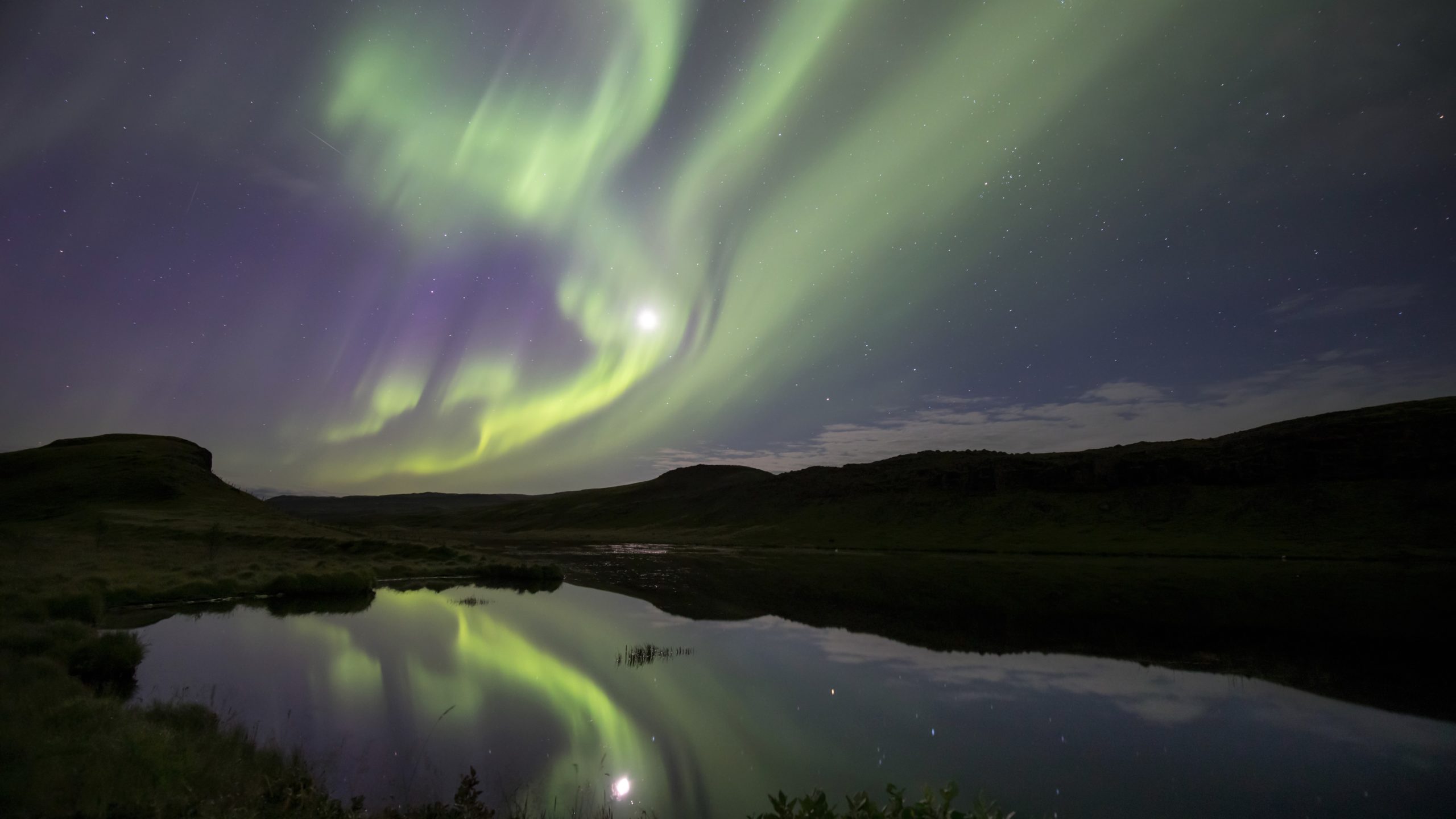
The two halves of the year
Most of us know about the four seasons and the special relationships that different places can have with them. There are dry seasons, seasons that bring great storms, and times when amazing blooms and colors transform the land. You’ve seen it in autumnal leaves, avenues of cherry blossoms, fields of fruit, and grasses that grow ten feet fall! Seasons were our clock before we had a better way to count the time- and here in Iceland that is truer than most.
If you’ve had the chance to visit Iceland, or any country in proximity to the poles, you may have already experienced the extreme patterns of light that I’m referencing. Tales of the ethereal “Midnight Sun”, or endless days of darkness that see no light. The closer to either pole you get, the more severe this pattern becomes.
Because of the tilt in the Earth’s axis, the polar regions of the Earth find themselves much closer to the sun in summer, and much further away during winter. As you move closer to the equator, many countries further down feel the echoes of these shifts in light as well. Some, even further north than Iceland, feel it even more.
You can see what the annual sun graph of Reykjavik looks like here. It’s a great way to get an idea of what the light will be like when you visit. Try it for your home, or a city far away from you. It’s amazing to see how differently we experience the world- even at the same time.
The Icelandic settlers of old had to balance their survival with this harsh cycle- and created a calendar to help them manage their livestock, their crops, and their morale. This old calendar still has bearing on society today, and its holidays are still beloved as reminders of the natural progression of this place, in a way that the modern global calendar sometimes is not.
This calendar was based heavily around solstices and equinoxes of the year, and with its 12 months it splits the year into two halves. These halves were the summer/nattleysi, or lack of night, and the winter/skammdegi days, or short days. All of these were checkpoints in the arc of time, and were visible and even ways to mark its passage in a place where it often felt as if there were only two seasons to measure.
It was a difficult life for the settlers, and surviving the winter was a cause for great celebration. You can tell when the local populace felt the breaking of winter at the end of April- because that is traditionally when Iceland marks the first day of summer, or sumardagurinn fyrsti. This is a national holiday, and it is celebrated on the first Thursday after April 18th. This is a day of festivals and merriment, even though it may not seem very summer-like in temperature or appearance. But for Icelanders, this day marks the end of the long dark, and the beginning of the lengthening of days.
At one time, it meant the increased likelihood of survival, and days where one could work, craft or read without the obstacle of losing the light.
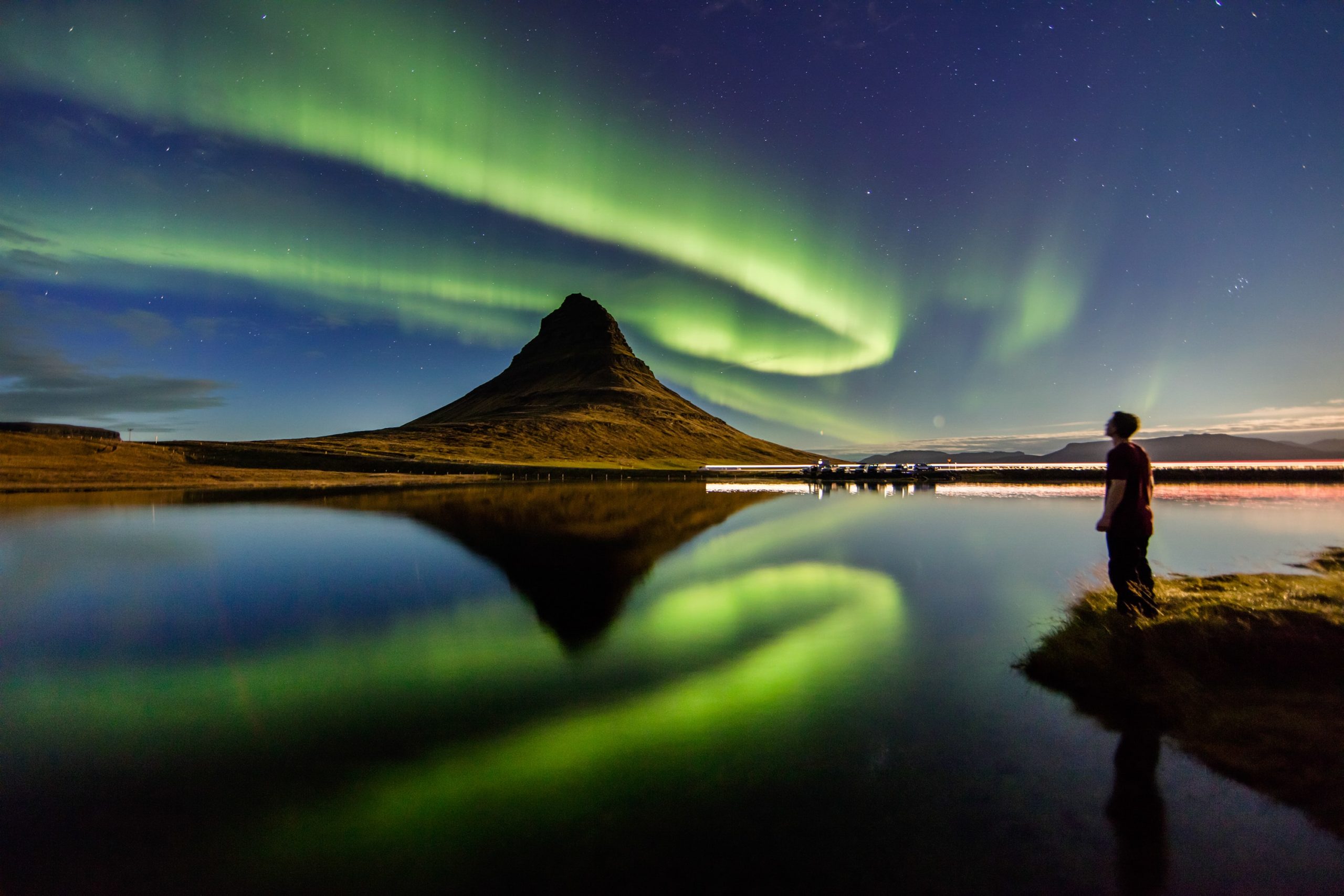
So where do the northern lights come in?
We know a little bit now about Iceland’s age-old relationship with seasonal time, light cycles, and surviving the harsh winters. But where do the northern lights come into all of that?
To give you the short version- the northern lights themselves can happen at any time.
They happen so far above our planet in space, that temperature, season, and time don’t mean too much when it comes to their arrival and creation. The first thing to realize about the aurora, is that it is a function of space weather before all else- but seeing it does require a little bit of cooperation from our own Earth weather, as well.
When an aurora is born, it is due to the sun releasing a solar storm into outer space. You can read more about that process here. We can track these storms to an extent because of the orbital patterns of the sun and the reappearance of sunspots, which more regularly release these strong systems. However, our ability to measure and predict space weather is still very much a developing science, and can be imperfect at times.
Despite all of that, the sun is releasing this energy all the time. Depending on the solar cycle and factors facing the travel of solar storms, this activity can find its way to us at any time of year, in any season. This means that it’s entirely possible for solar activity to arrive in our atmosphere in the middle of summer, or during the brightest point of day.
The difficulty here is actually with us. Auroral light is a visually delicate natural phenomenon, despite its volatile origins. To see it with the naked eye, we require darkness in order to pick up the low lumen light that it creates.
(An additional difficulty here lies with us as a species, because of how we perceive color visually in dark places. Because we are not nocturnal, our eyes are not designed to process color as well at nighttime, and so it’s already challenging for us as creatures to look at this type of light.)
Which is where we circle all the way back around to our first point- and Iceland’s dramatic dark and light seasons.
If the aurora arrives in the high point of summer when we experience only civil twilight, we wouldn’t be able to see it. It would technically be there, dancing and possibly displaying incredible colors- but we would only be able to see that from space at best. (And sometimes, NASA sends us a video of it!)
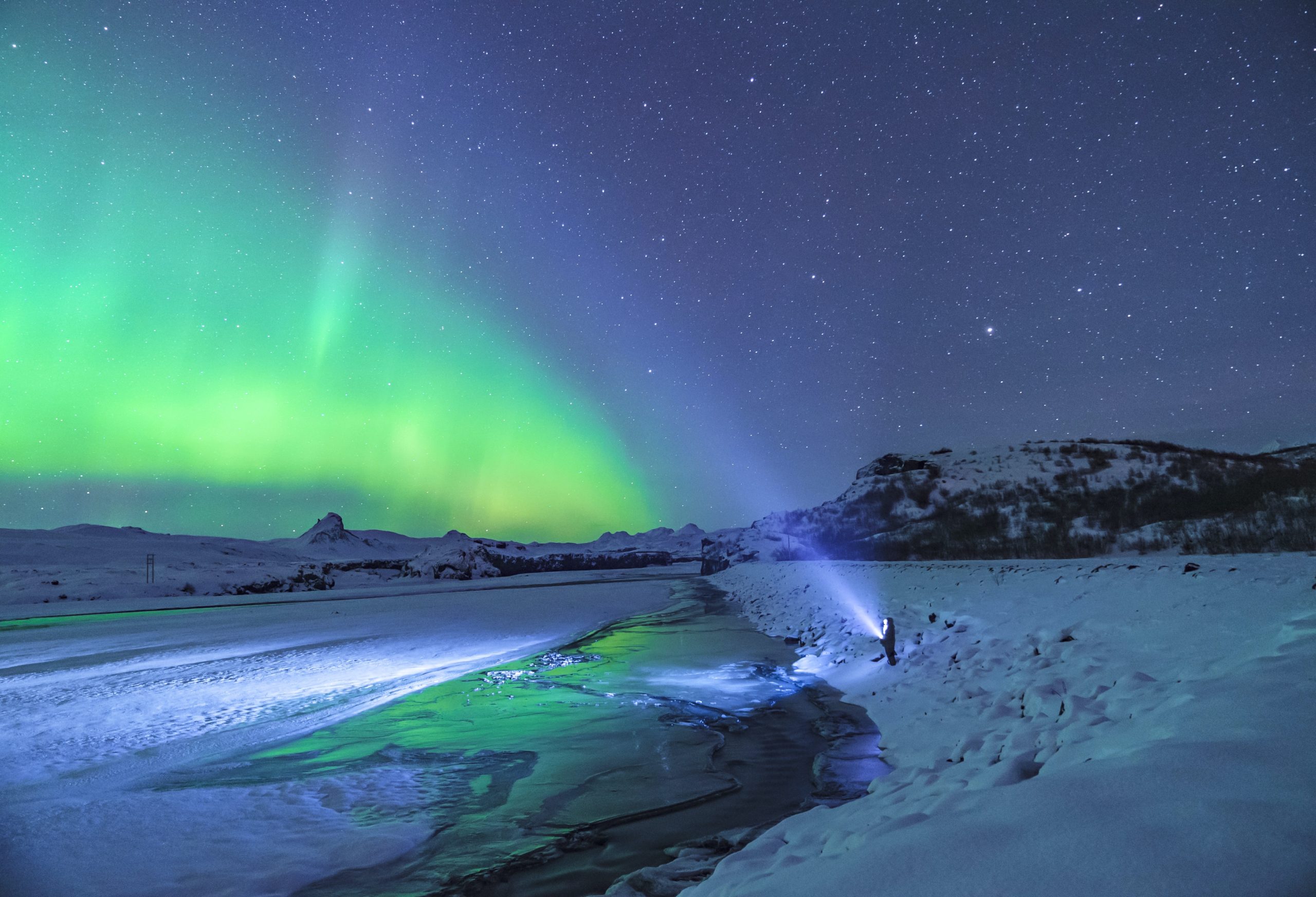
The same situation happens for us during the daytime, even in the winter months. Even though we only have a few actual hours of daylight, we still require the solid darkness of night to bring forth the best canvas for auroral glow.
Can we start our hunt earlier in the midwinter? Definitely! We can start heading out as early as 7 or 8pm on some nights, a thing that would be rather difficult to do in the earlier days of the auroral season. But we do still require that deep darkness of nighttime.
In Midsummer and Midwinter, we start to lose or gain minutes of sunlight. This means that once we hit Midsummer, we begin the ever-increasing trek to winter darkness. We don’t always notice this right away, but typically once we reach August, it becomes dark enough to witness the spectacle of northern lights.
For me, the earliest I have seen them was at the end of the first week of August. This is only the beginning though, and so I would likely wait until a bit later in the season (late September at the earliest), to plan a trip.
This darkness builds every day until mid-winter when we start to gain the sunlight back. This typically means that we can witness auroral light until the very beginning of April, though March is the popular cut-off. (Similar to August, April would be the very tail end of the possible season- and would be a risky time to book an aurora hunt.
Though, there are quite a few intrepid photographers that catch them that late in the year, with lots of practice, lots of experience, and a tiny bit of luck. It is, of course, Lady Aurora herself waving goodbye for the year- she loves a dramatic exit.)
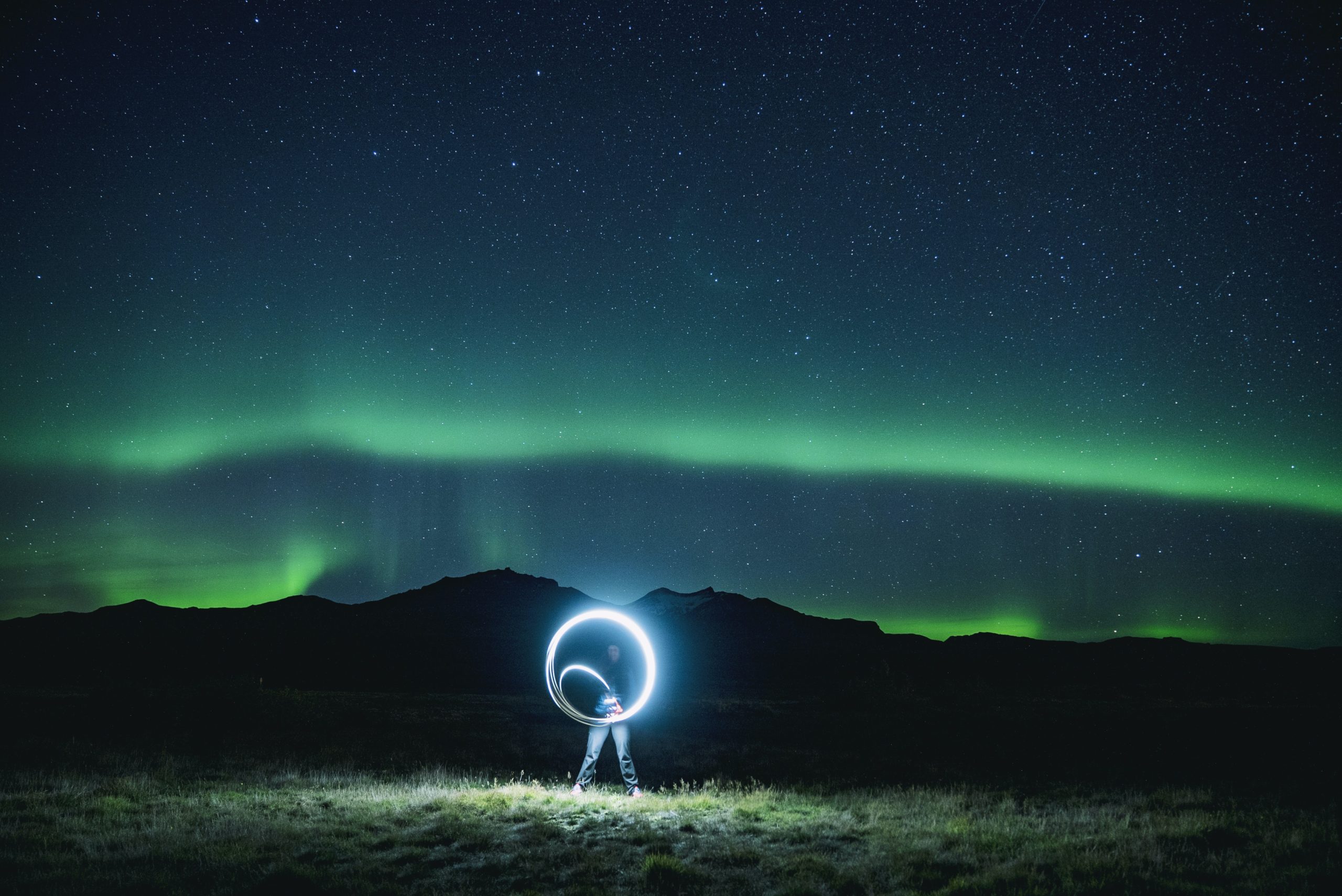
Some materials do talk about the ‘daytime aurora’, and this is not an incorrect statement. There are many places further north than Iceland (like Svalbard for example), that have an even more extreme sun graph than we do. (Though you can visit Siglufjörður, where they celebrate the first day that they see direct sunlight again.)
Places like this may not actually see the sun at all for quite some time- and maintain the ability to see northern lights for a longer period of time because of that. In addition to the extended dark hours during the day- they are also closer to the pole. Proximity to the pole can mean that they catch more of those low-level auroras that don’t travel very far out.
So don’t fret! The truth of the matter is that you have a whole half of the year to hunt for auroras in Iceland, as our forebears might say. (And for the other half of the year, you have puffins, endless lupine fields, and all the sun you can handle!)
But what about the weather?
You know about the Midnight Sun, the space weather that makes auroras, and the half of the year when we finally get enough darkness to see them. But what about Earth weather?
Earth weather does not interact with the northern lights, because it exists in the troposphere layer of our lower atmosphere. This is where most of the clouds in our atmosphere are located. It is sometimes said that extreme weather (things like polar vortexes and massive storms) can occur as far up as the stratosphere, but this is not entirely accurate. The stratosphere is particularly dry, and lacks the moisture to regularly create clouds, like the more humid troposphere.
To give you an idea of scale, these layers of the atmosphere combined are nearly 50 kilometres above the Earth. And still, it’s not high enough for auroras.
Auroral activity occurs in the ionosphere, a section of the atmosphere that overlaps the mesosphere and the thermosphere. This is an area of the atmosphere where a great deal of electrons and ionized atoms and molecules occur, thus housing a key part of the collision recipe that makes the visible aurora.
This means that myths about temperature and storms don’t necessarily hold true, and they don’t inhibit aurora activity. They do however get in the way of our viewing path.
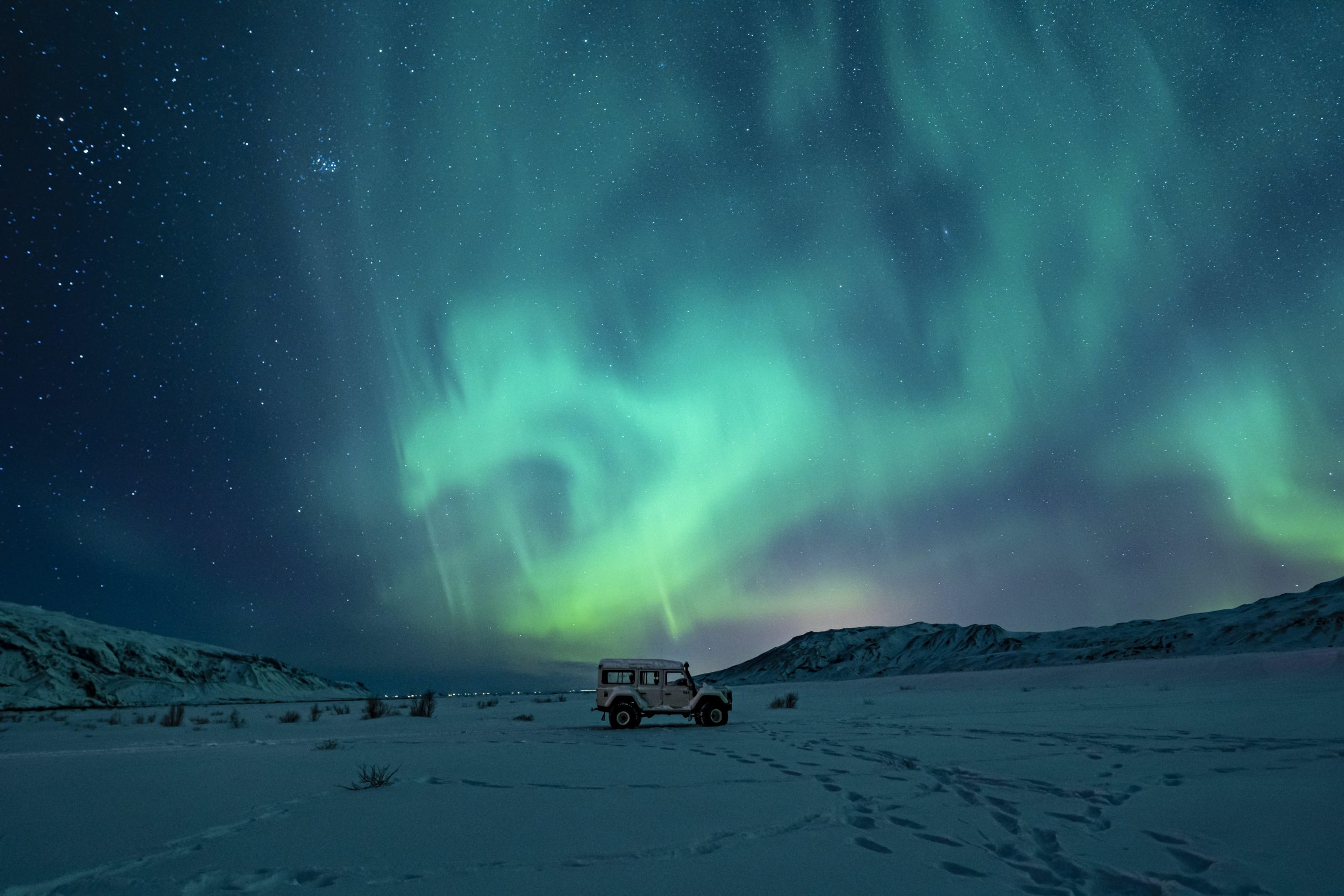
The view from Earth
Since we are watching from the Earth’s surface, anything that does happen in our weather system can get right in between us and the aurora. This means that sometimes the aurora forecast is great, and shows high solar activity and an incoming show- but if it’s cloudy, it’s as if someone pulled the curtains. The show goes on of course, but anyone under the cloud cover is missing it.
This is why the aurora forecast usually comes in two halves. The space weather or solar activity half (where we use the 0-8 Kp scale), and the Earth weather, or cloud map.
Much of what we are discerning before a night out hunting, is can we see the sky, where is it the clearest, is that clarity window moving due to wind- and if we can find a good spot to watch from, is there any solar activity?
Iceland is known for its rowdy winter weather, and depending on where you are in the country, you may find yourself exposed to some interesting micro climates and storms. The good news is, is that if you have the ability to travel and move around, sometimes it’s just as simple as driving over to the next cloudless spot. (And not forgetting the snacks, of course. It’s definitely a process some nights.)
Ready for the hunt: A Recap
You know it all, now! (Who am I kidding, nailing down space weather is a learning journey that never ends. At least not in our lifetime!)
Let’s do a onceover to make sure we’ve got our northern lights trip toolkit together.
First, we have to book a trip in the right half of the year. This means we’re headed to Iceland some time between September and March at best. (If you want to catch the tail end of August or the early start of April, you can try it, but it would not be a recommended time frame for northern lights.)
However, it is always good to remember that the northern lights are a natural phenomenon, so it is best to plan a trip first for the experience of visiting the place. Iceland is a wonder all on its own, and the northern lights are just one of its many gifts.
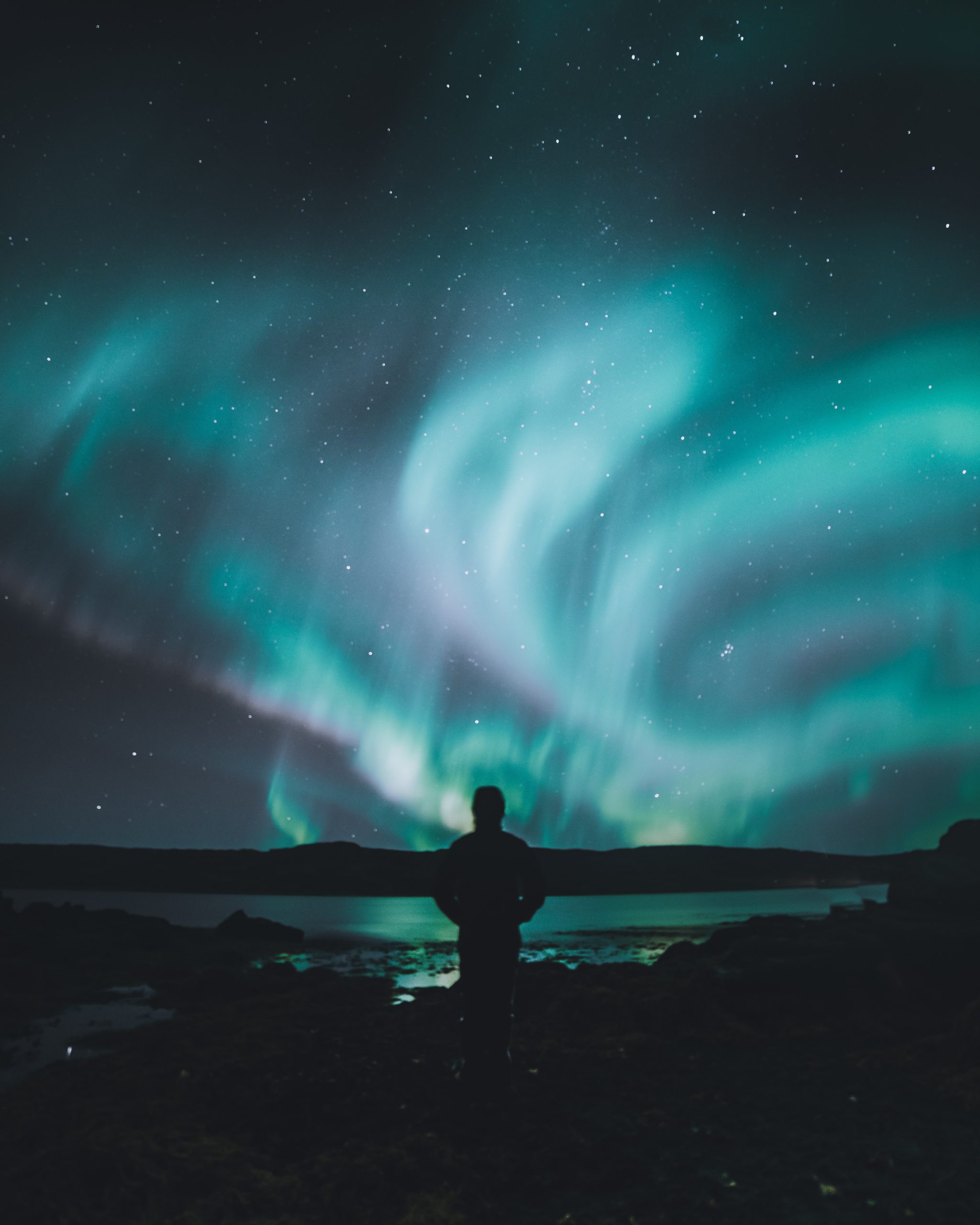
Assembling your Aurora Toolkit
Once you’ve booked your trip for the ‘aurora half’ of the year, you’ve got to remember all of the pieces that have to line up in order for a successful hunt.
These are things like making sure you’re out at night (not at 3:00 pm, even if you could swear it feels like midnight- which it kind of does in December-), making sure you’re in a clear area or an area that will become cloudless or ‘cloud light’ by nighttime, and of course, having a small check on if there’s any solar activity that evening.
It also helps to make sure you’re not in an area of extreme light pollution. Iceland is not populated by huge cities, so we do fairly well on this front, and it doesn’t typically take long to get out of the city and into some real nighttime. However, if you find yourself city-bound at any point, try looking for a spot that takes you out of the direct light and gives you a bit of a break on the eyes.
Remembering that the Aurora Forecast is not the last word!
It’s good to remember that many of these things are variable and imperfect, so it is not always necessary to plan by extremes- unless there is very inclement weather or a safety concern. (Those types of alerts always come first. Can’t enjoy the lights if you’re frozen.)
What I mean by this, is that forecasts are infallible. Not because they are in any way bad, but because weather is a volatile force that occasionally evades even the best of us.
This means that the cloud radar can be off or slow, and the Kp number may not be accurate. It is possible for forecasts to gauge the speed of a solar storm incorrectly, as there are many factors that can add to that figuring. It’ll probably be a few years before we nail down space weather, but I can guarantee that there are a lot of brilliant people working on it.
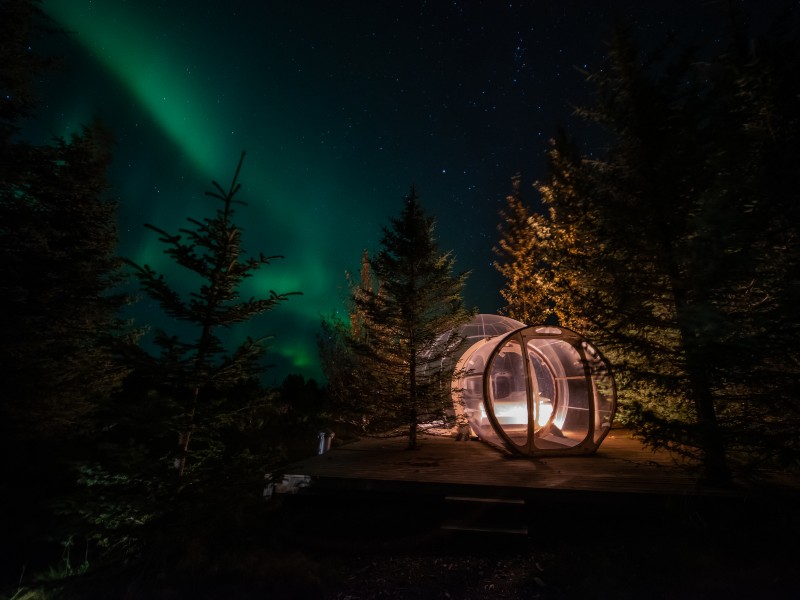
When the numbers don't add up, still look up!
This can mean that some nights, an aurora can occur on a Kp 0 evening. It can also mean that an exceptional evening (like a fabled Kp 8!), can disappoint us. This can happen for many reasons- which sometimes remain unknown to us. Sometimes powerful activity reaches so far that we end up in the middle of it instead, similar to being in the eye of a storm.
Sometimes it’s because we didn’t move very much on our hunt, and so we were only viewing one slice of the sky. It can happen that people see an aurora in one place, but a few kilometers over, nothing! Northern lights are like snowflakes in this way, and no two occurrences are alike. Forecasts are a great tool to have in your kit, and it can be good to cross reference a few good ones.
The TL;DR: Every aurora is a gift
Learning to decipher all of the different forecasting tools can be complex, but like many other information sources, being able to read a few different ones can sometimes give you a more comprehensive idea of what may be going on.
Sometimes, it can be that an aurora did happen, but it was a visually weak occurrence, and you did not realize you were seeing it. If you have only seen photographs of northern lights, it can be hard to recognize a low level manifestation- as they are not quite as neon and extreme as a photograph can be.
Nighttime photography uses processes like slow shutter speeds, aperture, and ISO to perceive light in darkness, in ways that our eyes cannot. This does not mean that auroras cannot be bright, or that all photos are photoshopped- but it does mean that the average occurrence will most likely not match the once-in-a-lifetime shot that you saw on a postcard.
Sometimes all of the factors are completely lined up, but there’s a weather warning, and it just isn’t a great night to chance it. The weather conditions can get very serious here very quickly, and are not worth risking.
All together, this sounds like a massive feat. The thing to take away is, that if you have a window of clarity in the sky, and you’re here in the magical half of the year that gives us this other kind of light, have a look. Once you know how much work it takes for the universe to produce one of these things, it feels miraculous that they happen at the frequency that they do.
Know that you may have to keep an eye out for longer than you’d expect sometimes, and you may not always be successful. But as every local knows, it is always worth looking up. They often happen when you least expect them. (..And it can also be nice to have a few drinks and a hot pot to soak in. You know. Or a transparent Bubble to wrap up in. Just saying.)
